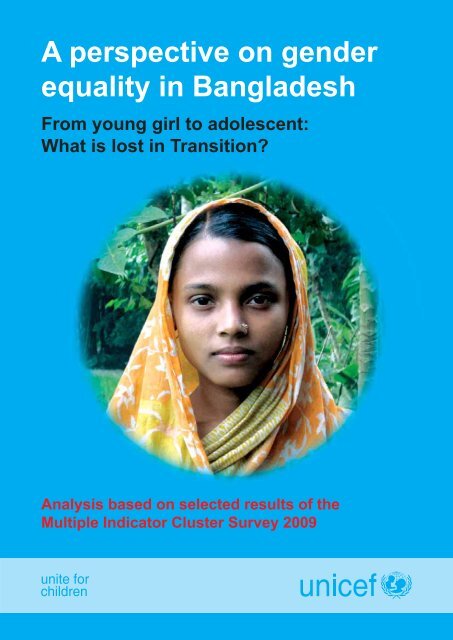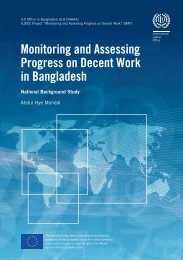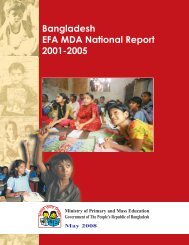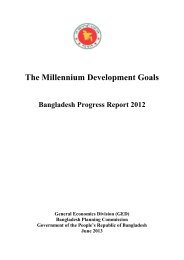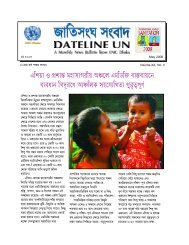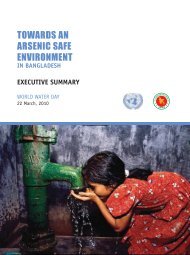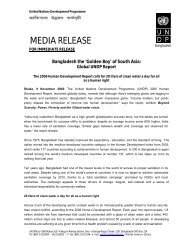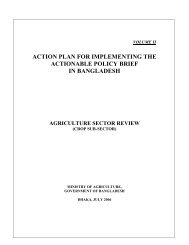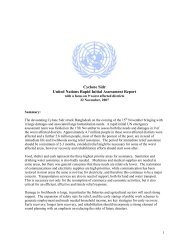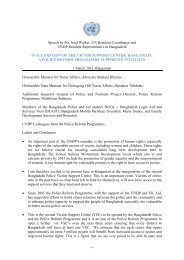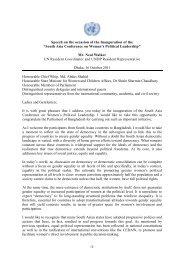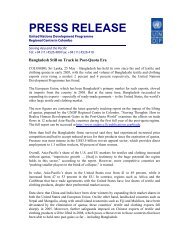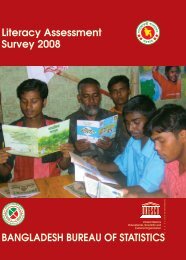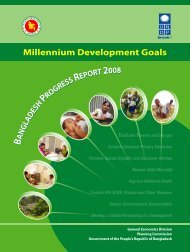A perspective on gender equality in Bangladesh - Unicef
A perspective on gender equality in Bangladesh - Unicef
A perspective on gender equality in Bangladesh - Unicef
You also want an ePaper? Increase the reach of your titles
YUMPU automatically turns print PDFs into web optimized ePapers that Google loves.
A <str<strong>on</strong>g>perspective</str<strong>on</strong>g> <strong>on</strong> <strong>gender</strong><strong>equality</strong> <strong>in</strong> <strong>Bangladesh</strong>From young girl to adolescent:What is lost <strong>in</strong> Transiti<strong>on</strong>?Analysis based <strong>on</strong> selected results of theMultiple Indicator Cluster Survey 2009
A <str<strong>on</strong>g>perspective</str<strong>on</strong>g> <strong>on</strong> <strong>gender</strong><strong>equality</strong> <strong>in</strong> <strong>Bangladesh</strong>From young girl to adolescent:What is lost <strong>in</strong> Transiti<strong>on</strong>?Analysis based <strong>on</strong> selected results of theMultiple Indicator Cluster Survey 2009UNICEF <strong>Bangladesh</strong>September 2011
AcknowledgementsThis report was prepared by Dirk Westhof, with c<strong>on</strong>tributi<strong>on</strong> from Carel deRooy, Luzma M<strong>on</strong>tano, Patricia Portela de Souza and Sarah SargentGrahamThis study was funded with UNICEF Regular Resources.© 2011 United Nati<strong>on</strong>s Children's Fund(UNICEF), <strong>Bangladesh</strong>All UNICEF materials are protected bycopyright, <strong>in</strong>clud<strong>in</strong>g text, photographs,images and videotapes. Permissi<strong>on</strong> toreproduce any part of this publicati<strong>on</strong>must be requested from:United Nati<strong>on</strong>s Children's FundBSL Office Complex1 M<strong>in</strong>to Road, Dhaka-1000<strong>Bangladesh</strong>Teleph<strong>on</strong>e: 88 02 8852266Email: dhaka@unicef.orgWebsite: www.unicef.org.bdThe views expressed <strong>in</strong> this report arethose of the c<strong>on</strong>sultant and do notnecessarily represent those of UNICEFISBN: 984-70292-0021-6Cover Photo:© UNICEF/NYHQ2009-2316/ShebaDesign & Layout:Dhrupadi
C<strong>on</strong>tentsExecutive summary 5Scope of the report 8I. Key c<strong>on</strong>cepts and theoretical framework relat<strong>in</strong>g to sex ratios and<strong>gender</strong>cide 9Female foeticide (sex selective aborti<strong>on</strong>) 9Survival disparity 10Gendercide 11"Miss<strong>in</strong>g women" 12Measur<strong>in</strong>g <strong>gender</strong>cide 13II. Benchmarks and comparis<strong>on</strong> 14Analysis of under-five mortality rates (U5MR) 15From discrim<strong>in</strong>ati<strong>on</strong> to n<strong>on</strong>-discrim<strong>in</strong>ati<strong>on</strong> 16Analysis of sex ratios - a closer look 19Educati<strong>on</strong> and <strong>gender</strong> 24Relati<strong>on</strong>ship between wealth and <strong>gender</strong> parity 27III.Manifestati<strong>on</strong>s of Discrim<strong>in</strong>ati<strong>on</strong>: The unaccounted for adolescentgirls 31IV. Discrim<strong>in</strong>ati<strong>on</strong> and violence aga<strong>in</strong>st young women 34V. C<strong>on</strong>clusi<strong>on</strong> - the future at stake 38VI. Recommendati<strong>on</strong>s for future acti<strong>on</strong> 40References 42Annex 45A <str<strong>on</strong>g>perspective</str<strong>on</strong>g> <strong>on</strong> <strong>gender</strong> <strong>equality</strong> <strong>in</strong> <strong>Bangladesh</strong>3
The comb<strong>in</strong>ed effect of these two f<strong>in</strong>d<strong>in</strong>gs (no higher girl-childmortality and no c<strong>on</strong>clusive evidence of female foeticide), wouldpo<strong>in</strong>t to absence of “<strong>gender</strong>cide”.3. The third <strong>in</strong>dicator presents positive trends for young andadolescent girls. In educati<strong>on</strong>, the <strong>gender</strong> parity is str<strong>on</strong>gly tilted<strong>in</strong> favor of girls. Girls are participat<strong>in</strong>g more, and better, <strong>in</strong> primaryeducati<strong>on</strong>; for <strong>in</strong>stance, more of them are reach<strong>in</strong>g grade 5.Thus, the first analysis po<strong>in</strong>ts to the absence of systematicdiscrim<strong>in</strong>ati<strong>on</strong> aga<strong>in</strong>st the young female child <strong>in</strong> <strong>Bangladesh</strong> asviewed from the lens of the positive trend <strong>in</strong> under-five mortalityrate. This is an encourag<strong>in</strong>g sign. However, a closer analysis ofthe sex ratios reveals a disturb<strong>in</strong>g picture given that the<strong>Bangladesh</strong> sex ratio is worry<strong>in</strong>gly higher than the normal humansex ratio. Anecdotic evidence str<strong>on</strong>gly suggests a culturalpreference for boys over girls <strong>in</strong> a male-dom<strong>in</strong>ated society whichmight exacerbate this imbalance.The analysis thus goes bey<strong>on</strong>d populati<strong>on</strong> rates. As young girlsgrow up, reach puberty (which <strong>in</strong> <strong>Bangladesh</strong> can be as early as10 years old) and become adolescents, the biological advantagewith which they were born succumbs to the weight of cultural andsocietal norms which shape <strong>gender</strong> differences that limit the fullenjoyment of their rights.By the same token, the positive <strong>gender</strong> parity <strong>in</strong>dex <strong>in</strong> educati<strong>on</strong>refers to the situati<strong>on</strong> of young girls. In adolescence, thegenerally-def<strong>in</strong>ed transiti<strong>on</strong> period between puberty and legaladulthood (ages 10-19), female school dropout rates soar. Theserates are str<strong>on</strong>gly related to the prevalence of social c<strong>on</strong>ductnorms such as not allow<strong>in</strong>g girls leave their homeunaccompanied, be<strong>in</strong>g subject to sexual harassment (eveteas<strong>in</strong>g)and physical and psychological violence (e.g. stalk<strong>in</strong>g).School drop-out rates are also str<strong>on</strong>gly related to child marriage,a pervasive practice <strong>in</strong> <strong>Bangladesh</strong> despite exist<strong>in</strong>g legislati<strong>on</strong>bann<strong>in</strong>g it.The analysis thus br<strong>in</strong>gs out the need for c<strong>on</strong>t<strong>in</strong>ued attenti<strong>on</strong> tothe c<strong>on</strong>sequences of <strong>gender</strong> <strong>in</strong>equalities and the requiredresp<strong>on</strong>ses at the political, social, normative-cultural andec<strong>on</strong>omic levels, for <strong>in</strong>stance:While the positive <strong>gender</strong> parity <strong>in</strong>dex <strong>in</strong> primary educati<strong>on</strong>is evidence of successful efforts <strong>in</strong> this area, start<strong>in</strong>g fromage ten, the opportunity cost of send<strong>in</strong>g girls (and boys) toschool <strong>in</strong>creases with their age.6A <str<strong>on</strong>g>perspective</str<strong>on</strong>g> <strong>on</strong> <strong>gender</strong> <strong>equality</strong> <strong>in</strong> <strong>Bangladesh</strong>
It is not <strong>on</strong>ly poverty that plays a hand <strong>in</strong> <strong>gender</strong> <strong>in</strong>equalitiesbut also the <strong>in</strong>tricate c<strong>on</strong>necti<strong>on</strong>s of cultural and social<strong>in</strong>fluences and practices. Gender <strong>in</strong>equalities not <strong>on</strong>ly affectyoung girls and women, but also boys and men. Animbalanced society impoverishes the lives and deprivesopportunities to girls and women, boys and men as theseprevail<strong>in</strong>g values permeate all society.Violence aga<strong>in</strong>st adolescent girls (and women and children)is epitomized by the barbaric practice of acid-throw<strong>in</strong>g, butalso physical punishment, stalk<strong>in</strong>g and sexual harassment(eve-teas<strong>in</strong>g) which drive many to (highly unreported)suicide.Greater efforts <strong>in</strong> educati<strong>on</strong>, change <strong>in</strong> social norms andc<strong>on</strong>diti<strong>on</strong>s, a c<strong>on</strong>ducive political and legal envir<strong>on</strong>ment, andgirls and women’s empowerment will help break this viciouscycle.The study c<strong>on</strong>cludes with a series of recommendati<strong>on</strong>s toaddress these broader issues of c<strong>on</strong>cern derived from theanalysis of three social development <strong>in</strong>dicators. Theserecommendati<strong>on</strong>s <strong>in</strong>clude c<strong>on</strong>certed efforts to raise awarenessand educate <strong>on</strong> <strong>gender</strong> <strong>equality</strong> at all levels of society fromgrassroots <strong>in</strong>itiatives to governmental policies and acti<strong>on</strong>. It isalso imperative to <strong>in</strong>vest <strong>in</strong> research ga<strong>in</strong> more <strong>in</strong>-depth <strong>in</strong>sightsto better understand the different forms of <strong>gender</strong> discrim<strong>in</strong>ati<strong>on</strong>that lead to <strong>in</strong>equalities throughout females' life cycle forevidence based policy and more effective acti<strong>on</strong>. There is needto assess the effectiveness of current educati<strong>on</strong> stipends and put<strong>in</strong> place more targeted schemes that take <strong>in</strong>to c<strong>on</strong>siderati<strong>on</strong> thehousehold, socioec<strong>on</strong>omic and geographical factors. A keyaspect is empowerment of adolescents through educati<strong>on</strong> <strong>on</strong>rights, reproductive health and elim<strong>in</strong>ati<strong>on</strong> of violence aga<strong>in</strong>stfemales. Fundamental changes will not happen if the socialstatus of girls and women <strong>in</strong> <strong>Bangladesh</strong>i society is not radicallyimproved. Hence, more specific strategies are needed toelim<strong>in</strong>ate child marriage by ensur<strong>in</strong>g full enforcement of the lawsrelat<strong>in</strong>g to early marriage and dowry, and devis<strong>in</strong>g social supportschemes to help prevent child marriage, dowry and other formsof abuse and exploitati<strong>on</strong> of young and adolescent girls. All thesenecessary acti<strong>on</strong>s require the collaborati<strong>on</strong> and partnership ofgovernment with civil society organizati<strong>on</strong>s, the private sector,the media, development partners and all other key stakeholdersto promote <strong>gender</strong> <strong>equality</strong> goals. Key roles and resp<strong>on</strong>sibilitiesmust be clearly laid out.A <str<strong>on</strong>g>perspective</str<strong>on</strong>g> <strong>on</strong> <strong>gender</strong> <strong>equality</strong> <strong>in</strong> <strong>Bangladesh</strong>7
Scope of the ReportThis report is based <strong>on</strong> additi<strong>on</strong>al analysis of the 2009 MultipleIndicator Cluster Survey (MICS) / Progotir Pathey results. The 2009MICS was c<strong>on</strong>ducted by the <strong>Bangladesh</strong> Bureau of Statistics (BBS)and was designed to provide estimates <strong>on</strong> a few <strong>in</strong>dicators <strong>on</strong> thesituati<strong>on</strong> of children and women for urban and rural areas at thenati<strong>on</strong>al, district and upazila levels. The MICS was a large survey of300,000 households. In the <strong>in</strong>terviewed households, over 333,000women aged 15-49 years old were <strong>in</strong>terviewed. In order to place theMICS 2009 data <strong>in</strong>to <str<strong>on</strong>g>perspective</str<strong>on</strong>g>, comparis<strong>on</strong>s were made with MICS2006 and DHS 2007 data.The analysis starts by exam<strong>in</strong><strong>in</strong>g theoretical frameworks regard<strong>in</strong>gfemale foeticide, <strong>gender</strong>cide and "miss<strong>in</strong>g women" draw<strong>in</strong>g fromvarious sources. This report uses Amartya Sen's c<strong>on</strong>cept of "miss<strong>in</strong>gwomen" and used the method he developed to calculate the estimatednumber of "miss<strong>in</strong>g women" <strong>in</strong> <strong>Bangladesh</strong>. This orig<strong>in</strong>al c<strong>on</strong>cept of"miss<strong>in</strong>g women" is broadened <strong>in</strong> this report to discuss the c<strong>on</strong>cept ofunaccounted for or statistically <strong>in</strong>visible girls.The analysis seeks to substantiate, through the under-five mortalityratio and sex ratios, the absence of female discrim<strong>in</strong>ati<strong>on</strong> <strong>in</strong> mortalityand this is c<strong>on</strong>firmed by the absence of discrim<strong>in</strong>ati<strong>on</strong> <strong>in</strong> care ofillness, nutriti<strong>on</strong> and other health <strong>in</strong>dicators like vacc<strong>in</strong>ati<strong>on</strong>. Theanalysis of the net attendance ratios seeks to establish whether thisapparent n<strong>on</strong>-discrim<strong>in</strong>ati<strong>on</strong> of the young girl (0-9 years old), carriesthrough <strong>in</strong>to adolescence. <strong>Bangladesh</strong> does not follow the Indian andCh<strong>in</strong>ese patterns regard<strong>in</strong>g the sex ratios. However, there is<strong>in</strong>creas<strong>in</strong>g evidence that this situati<strong>on</strong> might change.While the MICS survey results used to develop this report <strong>on</strong> theGender <str<strong>on</strong>g>perspective</str<strong>on</strong>g> <strong>in</strong> <strong>Bangladesh</strong> are based <strong>on</strong> a very large nati<strong>on</strong>alsample survey, cauti<strong>on</strong> is exercised when analyz<strong>in</strong>g sex ratios. At thedistrict level, but especially at the upazila level, statistical variance isexpected result<strong>in</strong>g from relatively smaller sample sizes at these lowerlevels compared to nati<strong>on</strong>al and divisi<strong>on</strong>al estimates.8A <str<strong>on</strong>g>perspective</str<strong>on</strong>g> <strong>on</strong> <strong>gender</strong> <strong>equality</strong> <strong>in</strong> <strong>Bangladesh</strong>
© UNICEF/NYHQ2009-2304/NesaI. Key c<strong>on</strong>cepts and theoreticalframework relat<strong>in</strong>g to sexratios and <strong>gender</strong>cideFemale Foeticide (sex selective aborti<strong>on</strong>)The general focus of attenti<strong>on</strong> regard<strong>in</strong>g abnormal sex ratios isfemale foeticide. In India for <strong>in</strong>stance, despite the ban <strong>on</strong> <strong>gender</strong>determ<strong>in</strong>ati<strong>on</strong> via ultra-sound, the practice c<strong>on</strong>t<strong>in</strong>ues and is evenexacerbated as decl<strong>in</strong><strong>in</strong>g birth rates <strong>on</strong>ly re<strong>in</strong>force the pressureexerted by the cultural preference for boys.In March 2010, The Ec<strong>on</strong>omist reported that Ch<strong>in</strong>a had three regi<strong>on</strong>swith a sex ratio at birth above 130. It also f<strong>in</strong>ds that <strong>in</strong> India, where nodata exists <strong>on</strong> sex ratios at birth, the rate for children up to six yearsrose from the biological norm of 104 <strong>in</strong> 1981 to 105.8 males per 100females <strong>in</strong> 1991 to a biologically impossible ratio of 108 <strong>in</strong> 2001 withseveral districts present<strong>in</strong>g a sex ratio of over 125. The results fromA <str<strong>on</strong>g>perspective</str<strong>on</strong>g> <strong>on</strong> <strong>gender</strong> <strong>equality</strong> <strong>in</strong> <strong>Bangladesh</strong>9
the 2011 census <strong>in</strong> India showed 914 girls aged six and under forevery 1,000 boys. This trend is still persistently imbalanced s<strong>in</strong>cewithout <strong>in</strong>terventi<strong>on</strong> more boys would be born than girls. If comparedto a normal sex ratio, then 600,000 girls <strong>in</strong> India go miss<strong>in</strong>g each year(The Ec<strong>on</strong>omist, 2011). A recent analysis <strong>on</strong> Ch<strong>in</strong>a <strong>in</strong>dicates that thesex ratio imbalance <strong>in</strong> that country has reached such an alarm<strong>in</strong>glevel that, by 2020, men of marriageable age are estimated tooutnumber women by 24 milli<strong>on</strong> (Lee, 2011).Survival disparityThe sec<strong>on</strong>d aspect, female disadvantage <strong>in</strong> mortality of children, isgiven less attenti<strong>on</strong> <strong>in</strong> world literature but has the samec<strong>on</strong>sequences. In some parts, <strong>on</strong>ce born, the girl child has traditi<strong>on</strong>allybeen neglected relative to the boy as she is c<strong>on</strong>sidered both socially<strong>in</strong>ferior and a liability as a bride’s dowry can cripple a poor familyf<strong>in</strong>ancially 2 . This results <strong>in</strong> higher girl child mortality.Analysis of sex disparities <strong>in</strong> health and educati<strong>on</strong> showed that theseare higher <strong>in</strong> South Asia than anywhere else <strong>in</strong> the world.Researchers estimate that child mortality would drop by 20 per cent ifgirls had the same mortality rate as boys between the ages of <strong>on</strong>em<strong>on</strong>th and five years. The reas<strong>on</strong>s for this <strong>in</strong>equity <strong>in</strong> sex are socioec<strong>on</strong>omicand behavioral. Girls are often brought to health facilities <strong>in</strong>more advanced states of illness than boys, and taken to less qualifieddoctors when ill. Less m<strong>on</strong>ey is spent <strong>on</strong> medic<strong>in</strong>es for girls comparedwith boys. Girls are less likely to receive treatment than boys (Victora,2003). For <strong>in</strong>stance <strong>in</strong> Uttar Pradesh, India, parents discrim<strong>in</strong>ateaga<strong>in</strong>st baby girls, as they receive less food, less attenti<strong>on</strong> when illand c<strong>on</strong>sequently deaths <strong>in</strong> this group are higher than normally wouldbe the case.InfanticideThe practice of neglect/discrim<strong>in</strong>ati<strong>on</strong> that results <strong>in</strong> higher girl mortalityis not to be c<strong>on</strong>fused with <strong>in</strong>fanticide. Infanticide is the practice of<strong>in</strong>tenti<strong>on</strong>ally kill<strong>in</strong>g an <strong>in</strong>fant. This issue is not addressed <strong>in</strong> this report.Still births and per<strong>in</strong>atal mortalityAs noted <strong>in</strong> other surveys such as DHS, the dist<strong>in</strong>cti<strong>on</strong> betweenstillbirth (occurr<strong>in</strong>g after seven completed m<strong>on</strong>ths of gestati<strong>on</strong>) and anearly ne<strong>on</strong>atal death (deaths with<strong>in</strong> seven days of life) is very delicatebecause the causes of these two overlap (Cousens, 2011).2 This liability is exacerbated with age and educati<strong>on</strong>.10A <str<strong>on</strong>g>perspective</str<strong>on</strong>g> <strong>on</strong> <strong>gender</strong> <strong>equality</strong> <strong>in</strong> <strong>Bangladesh</strong>
The tendency is then to comb<strong>in</strong>e these two events together whenpresent<strong>in</strong>g survey results. The 2007 results show that per<strong>in</strong>atalmortality is higher am<strong>on</strong>g teenage mothers than women age 20 orabove and higher <strong>in</strong> rural areas than <strong>in</strong> urban areas. This issue isrelevant to the analysis of this report because <strong>in</strong> many countries, and<strong>Bangladesh</strong> cannot be an excepti<strong>on</strong>, stillbirth and early ne<strong>on</strong>ataldeaths are not <strong>in</strong>cluded <strong>in</strong> the nati<strong>on</strong>al systems for vital registrati<strong>on</strong>.Given that the causes of still births and per<strong>in</strong>atal deaths are poorlyunderstood and also the absence of statistics by sex of the foetus orbaby, this issue is not given full c<strong>on</strong>siderati<strong>on</strong> <strong>in</strong> this report but a studyfocus<strong>in</strong>g <strong>on</strong> this very critical issue is needed as it clearly reflectssocioec<strong>on</strong>omic disparities and women's reproductive rights issues.The stillbirth burden is grossly underestimated. Such under estimati<strong>on</strong>is due to under-report<strong>in</strong>g, <strong>in</strong>c<strong>on</strong>sistent def<strong>in</strong>iti<strong>on</strong>s, and the fact thatstillbirths do not feature <strong>in</strong> major global or nati<strong>on</strong>al health targets andcommitments (Darmstadt, 2011).GendercideAccord<strong>in</strong>g to Amartya Sen, <strong>gender</strong> <strong>in</strong><strong>equality</strong> <strong>in</strong> many parts of theworld takes the form of unusually high mortality rates am<strong>on</strong>g womenat all ages. As a c<strong>on</strong>sequence, there is a prep<strong>on</strong>derance of men <strong>in</strong> thetotal populati<strong>on</strong>. This is the comb<strong>in</strong>ed effect of <strong>gender</strong>cide.Sen observes that both phenomena (sex selective aborti<strong>on</strong>s andfemale disadvantage <strong>in</strong> mortality of children) reflect anti-female biasand can occur <strong>in</strong> c<strong>on</strong>juncti<strong>on</strong> with each other. In India, an observedtrend is also that <strong>in</strong> richer areas the focus is <strong>on</strong> foeticide while <strong>in</strong>poorer areas the focus is <strong>on</strong> higher girl-child mortality (neglect). Thesetwo facets of <strong>gender</strong>cide result <strong>in</strong> a skewed sex ratio at birth and aneven more skewed under-five sex ratio. India’s sex ratio shows that<strong>gender</strong>cide is a feature not just of poverty or political system. UnlikeCh<strong>in</strong>a, India is a democracy and there is no <strong>on</strong>e-child policy to blame.Although parts of the country are poor, poverty al<strong>on</strong>e does not expla<strong>in</strong>India’s preference for s<strong>on</strong>s. The states with the worst sex ratios—Punjab, Haryana, Gujarat—are am<strong>on</strong>g the richest.<strong>Bangladesh</strong> sex ratios cannot be expla<strong>in</strong>ed by poverty al<strong>on</strong>e either.Anecdotic evidence str<strong>on</strong>gly suggests a cultural preference for boys;women see it as a failure when they deliver a girl. The <strong>Bangladesh</strong>2009 MICS data offers evidence <strong>in</strong> this respect. Mothers recalledbetter issues related to their s<strong>on</strong>s than to their daughters, as reflected<strong>in</strong> the “Children Ever Born” overall ‘sex ratio’ of 131. The questi<strong>on</strong> ishow much l<strong>on</strong>ger <strong>Bangladesh</strong> can resist the South-Asia pressure for<strong>gender</strong>cide, especially given the c<strong>on</strong>t<strong>in</strong>u<strong>in</strong>g drop <strong>in</strong> birth rates thatheightens the desire of couples to give birth to a boy.A <str<strong>on</strong>g>perspective</str<strong>on</strong>g> <strong>on</strong> <strong>gender</strong> <strong>equality</strong> <strong>in</strong> <strong>Bangladesh</strong>11
Miss<strong>in</strong>g WomenGiven similar health care and nutriti<strong>on</strong>, women tend typically to havelower age-specific mortality rates than men do (Osmani & Sen, 2003).Throughout their respective lives the proporti<strong>on</strong> of males goes <strong>on</strong>fall<strong>in</strong>g as we move to higher and higher age groups, due to typicallygreater male mortality rates. The excess of females over males <strong>in</strong> thepopulati<strong>on</strong> of Europe and North America results from this greatersurvival chance of females <strong>in</strong> different age groups.Amartya Sen wrote already <strong>in</strong> 1990: "It has been widely observedthat, given similar health care and nutriti<strong>on</strong>, women tend typically tohave lower age specific mortality rates than men. Even thougheverywhere <strong>in</strong> the world more male babies are born than femalebabies, <strong>in</strong> those places with equity, the overabundance of men isgradually reduced and then reversed. So the populati<strong>on</strong>s of forexample Europe have about 105 or more females per 100 males <strong>in</strong>the total populati<strong>on</strong>. However <strong>in</strong> many regi<strong>on</strong>s of the world there is a<strong>gender</strong> bias <strong>in</strong> health care and social attenti<strong>on</strong> and mortality rates offemales are unusually high compared with what may be expectedfrom the local male mortality rates. Indeed, quite often female mortalityrates actually exceed the male rates, <strong>in</strong> total c<strong>on</strong>trast with what isbiologically expected".Amartya Sen <strong>in</strong>troduced the c<strong>on</strong>cept of "miss<strong>in</strong>g women", devised togive some idea of the enormity of this phenomen<strong>on</strong> by focus<strong>in</strong>g <strong>on</strong> thewomen who are simply not there. His rather rough methodology<strong>in</strong>volves estimat<strong>in</strong>g the quantitative difference between the actualnumber of women <strong>in</strong> these countries and the number we could expectto see had the <strong>gender</strong> ratio <strong>in</strong> survival been similar (Sen, 1990). As abenchmark the sex ratio <strong>in</strong> sub-Saharan Africa was taken, 102 (andnot the 105 from Europe) female to male ratio (Anders<strong>on</strong> & Ray,2010).Even the use of 102 results <strong>in</strong> a large number of "miss<strong>in</strong>g women".The overall (total populati<strong>on</strong>) sex ratio <strong>in</strong> <strong>Bangladesh</strong> accord<strong>in</strong>g to theSample Vital Registrati<strong>on</strong> System and MICS 2009 is 95 females tomales (or 105 males to females). Thus, there is a relative deficit ofwomen of 7% of the <strong>Bangladesh</strong> male populati<strong>on</strong>. This already yieldsa figure of 5 milli<strong>on</strong> "miss<strong>in</strong>g" or unaccounted for women <strong>in</strong><strong>Bangladesh</strong>. (Male populati<strong>on</strong> <strong>in</strong> 2009 is 72 milli<strong>on</strong> accord<strong>in</strong>g to theSVRS, 7 per cent of 72 milli<strong>on</strong> is 5 milli<strong>on</strong>).Seek<strong>in</strong>g to identify where these unaccounted for, "miss<strong>in</strong>g" femalesare, an analysis <strong>in</strong> the MICS shows a low number of girls aged 15-19years old; another clue is the sex ratio of people aged above 65years, which is 70 females per 100 males. This is c<strong>on</strong>trary to thenorm. Because women live l<strong>on</strong>ger than men, that segment of the12A <str<strong>on</strong>g>perspective</str<strong>on</strong>g> <strong>on</strong> <strong>gender</strong> <strong>equality</strong> <strong>in</strong> <strong>Bangladesh</strong>
populati<strong>on</strong> is normally tilted heavily towards women. For <strong>in</strong>stance, <strong>in</strong> asociety where no bias exists aga<strong>in</strong>st females such as the Netherlands,the above 100 year-old populati<strong>on</strong> has a sex ratio of 700 females per100 males.Measur<strong>in</strong>g GendercideStudies have found that male <strong>in</strong>fants have higher mortality from mostcauses of death, and the sex differential varies by cause. Forexample, females have more vigorous immune resp<strong>on</strong>ses and greaterresistance to <strong>in</strong>fecti<strong>on</strong>, they also have lower mortality from <strong>in</strong>fecti<strong>on</strong>sand respiratory ailments; <strong>on</strong> the other hand, males are more likely tobe born prematurely and to suffer from respiratory c<strong>on</strong>diti<strong>on</strong>s <strong>in</strong> theper<strong>in</strong>atal period (Drevenstedt, 2008). To compensate, nature resp<strong>on</strong>dswith a mechanism where more boys are born than girls so that therewill be an equal number of males and females at puberty. In allsocieties that record births, between 103 and 106 boys are normallyborn for every 100 girls. The world average is 105 males per 100females (or 51.2% of all births are boys).The sex ratio of under-<strong>on</strong>es is already <strong>in</strong>fluenced by the <strong>in</strong>fantmortality rate (IMR). In general the IMR is at least 20 per cent higherfor males. Thus the normal sex ratio for under-<strong>on</strong>es is 104 while forunder-fives it is 103-104 depend<strong>in</strong>g <strong>on</strong> the child mortality level.Usually at age 18 the sex ratio is almost even and at higher agesthere are normally many more women than men.To test the hypothesis of female foeticide, <strong>in</strong> the absence of data <strong>on</strong>sex ratios at birth <strong>in</strong> the MICS 2009, the next best opti<strong>on</strong> was toanalyze the under <strong>on</strong>e sex ratio, as the group closest to birth, andthus less <strong>in</strong>fluenced by other events. However, it should be noted that<strong>in</strong> this analysis, the ratio is <strong>in</strong>fluenced by statistical variance becauseof the smaller size of this populati<strong>on</strong> group and for that reas<strong>on</strong> the useof the under-five populati<strong>on</strong> sex ratio is deemed best suited for thisanalysis.A <str<strong>on</strong>g>perspective</str<strong>on</strong>g> <strong>on</strong> <strong>gender</strong> <strong>equality</strong> <strong>in</strong> <strong>Bangladesh</strong>13
© UNICEF/BANA2008-00826/NooraniII.Benchmarks and Comparis<strong>on</strong>While the human sex ratio is comm<strong>on</strong>ly assumed to be 105, cauti<strong>on</strong> isrequired when analyz<strong>in</strong>g sex ratio data as <strong>in</strong> countries like the UnitedStates the white populati<strong>on</strong> has a sex ratio at birth of 106 and theblack populati<strong>on</strong>’s sex ratio at birth is 104. Thus a small deviati<strong>on</strong> fromthe 105 ratio can be c<strong>on</strong>sidered ‘natural’. In surveys, the risk ofsignificant statistical variati<strong>on</strong> <strong>in</strong>creases with smaller samples, hence itis best to base the analysis <strong>on</strong> data from large enough samples ormultiple year averages, when available.However, a larger deviati<strong>on</strong> from the 105 norm, if reliably measured,would be c<strong>on</strong>sidered a "biologically impossible ratio", and this would<strong>on</strong>ly be the result of sex selective aborti<strong>on</strong> and/or neglect towards thechild. We will use the under-five ratio of 108 (males to 100 females) asthe benchmark for biologically impossible sex ratios <strong>in</strong> this study asused <strong>in</strong> other studies as well. The ratio to be used for the under-<strong>on</strong>e sexratio is 109.14A <str<strong>on</strong>g>perspective</str<strong>on</strong>g> <strong>on</strong> <strong>gender</strong> <strong>equality</strong> <strong>in</strong> <strong>Bangladesh</strong>
Analysis of under-five mortality rates (U5MR)The MICS 2009 U5MR data, based <strong>on</strong> the <strong>in</strong>direct (Brass) method 3 ,presents reliable results at both nati<strong>on</strong>al and divisi<strong>on</strong>al levels.The generally accepted differential between male and female mortalityis a twenty percent variance between the two, <strong>in</strong> favor of the girls.This is c<strong>on</strong>sistent with exist<strong>in</strong>g theories posit<strong>in</strong>g that boys are morelikely to die shortly after birth than girls because baby girls have morevigorous immune resp<strong>on</strong>ses and greater resistance to <strong>in</strong>fecti<strong>on</strong> thanbaby boys (Drevenstedt, 2008). Per the table below, <strong>Bangladesh</strong> isperform<strong>in</strong>g even better than the norm <strong>in</strong> some geographic areas.Male and female U5MR <strong>in</strong> the divisi<strong>on</strong>s of<strong>Bangladesh</strong>(Per 1,000 live births)Male U5MR Female U5MR Female lower by %Barisal 67 51 24%Chittag<strong>on</strong>g 63 49 22%Dhaka 74 60 19%Khulna 68 45 34%Rajshahi 75 57 24%Sylhet 81 66 19%Nati<strong>on</strong>al 72 55 24%3 The <strong>in</strong>direct Brass method c<strong>on</strong>verts the proporti<strong>on</strong> of dead children ever born reported by women <strong>in</strong>age groups 15-19, 20- 24, 45-49 <strong>in</strong>to estimates of probability of dy<strong>in</strong>g before atta<strong>in</strong><strong>in</strong>g certa<strong>in</strong> exactchildhood ages. The method assumes that the age of the mother can serve as a proxy for the age ofher children and thus for how l<strong>on</strong>g they have been exposed to the risk of dy<strong>in</strong>g. For more <strong>in</strong>formati<strong>on</strong><strong>on</strong> this method please checkhttp://unstats.un.org/unsd/mdg/Metadata.aspx?IndicatorId=0&SeriesId=561.A <str<strong>on</strong>g>perspective</str<strong>on</strong>g> <strong>on</strong> <strong>gender</strong> <strong>equality</strong> <strong>in</strong> <strong>Bangladesh</strong>15
U5MR Over Time(Per 11000 live births)120100809993918981747066 65607540595550 502001994 1997 2000 2003 2004 2005 2007Male U5MRFemale U5MRU5MR trend over timeBefore the year 2000 male and female U5MR were almost the same.This would suggest possible discrim<strong>in</strong>ati<strong>on</strong> aga<strong>in</strong>st girls. In recentyears, the U5MR has come down steeply for girls, which has resulted<strong>in</strong> a ratio that would be c<strong>on</strong>sidered normal.From discrim<strong>in</strong>ati<strong>on</strong> to n<strong>on</strong>-discrim<strong>in</strong>ati<strong>on</strong>This same trend was signaled <strong>in</strong> the 2007 DHS report where datasuggested that male children experience higher ne<strong>on</strong>atal mortalitythan female children. In c<strong>on</strong>trast, rates that do not <strong>in</strong>clude the firstm<strong>on</strong>th of life are similar for male and female children. The DHS 2007c<strong>on</strong>firms the f<strong>in</strong>d<strong>in</strong>gs from the DHS 2004 that there is no l<strong>on</strong>ger anotable difference <strong>in</strong> the post ne<strong>on</strong>atal and under five mortality ratesof male and female children.16A <str<strong>on</strong>g>perspective</str<strong>on</strong>g> <strong>on</strong> <strong>gender</strong> <strong>equality</strong> <strong>in</strong> <strong>Bangladesh</strong>
DHS 2007 Male and Female Mortality Results(Per 11000 live births)80706061547672504030201001620IMR(0-12 m<strong>on</strong>ths)Child mortality(12-59 m<strong>on</strong>ths)U5MR(0-59 m<strong>on</strong>ths)MaleFemaleHowever despite the observati<strong>on</strong>s <strong>in</strong> the DHS 2007 report, which arelargely validated by the MICS 2009 results, the fact is that femalechild mortality is higher.Health data from other sourcesThe above presented mortality results are further substantiated by the<strong>in</strong>termediate health variables. No discrim<strong>in</strong>ati<strong>on</strong> is observed whenanalyz<strong>in</strong>g health data as presented <strong>in</strong> MICS 2006 and the DHS 2007.As we see, DHS nutriti<strong>on</strong> data shows no bias. The same pattern isobserved <strong>in</strong> the MICS 2006:A <str<strong>on</strong>g>perspective</str<strong>on</strong>g> <strong>on</strong> <strong>gender</strong> <strong>equality</strong> <strong>in</strong> <strong>Bangladesh</strong>17
MICS 2006, Results for boys and girlsunder-five100.080.070.7Per cent60.040.069.336.0 39.085.0 83.0Male Female20.021.8 21.20.0Coveragewith all basicvacc<strong>in</strong>ati<strong>on</strong>sAntibiotictreatment ofpneum<strong>on</strong>iaORTUse RateExclusivelybreastfed(0-5 m<strong>on</strong>ths)DHS 2007, Nutriti<strong>on</strong> results for boys andgirls under-five50.040.043.7 42.740.042.0Per cent30.020.018.416.510.00.0stunt<strong>in</strong>g Wast<strong>in</strong>g Malnutriti<strong>on</strong>MaleFemaleThe data for the above selected health <strong>in</strong>dicators leads to c<strong>on</strong>cludethat there is no perceivable sex bias <strong>in</strong> use of health services,although generally more attenti<strong>on</strong> is paid to boys’ health than to girls’18A <str<strong>on</strong>g>perspective</str<strong>on</strong>g> <strong>on</strong> <strong>gender</strong> <strong>equality</strong> <strong>in</strong> <strong>Bangladesh</strong>
health. From this <str<strong>on</strong>g>perspective</str<strong>on</strong>g>, there appears to be an absence ofabove-normal differences <strong>in</strong> mortality.Analysis of sex ratios a closer lookAs po<strong>in</strong>ted out earlier, <strong>gender</strong> discrim<strong>in</strong>ati<strong>on</strong> has three key populati<strong>on</strong>outcomes:a) Female foeticide, as expressed <strong>in</strong> the sex ratio at birthb) Higher girl child mortality(The comb<strong>in</strong>ed effect of these two is <strong>gender</strong>cide)c) "Miss<strong>in</strong>g women", Amartya Sen's <strong>in</strong>dicator s<strong>in</strong>ce 1990,based up<strong>on</strong> the sex ratio <strong>in</strong> the total populati<strong>on</strong>. This is thecumulative effect of past discrim<strong>in</strong>ati<strong>on</strong>.The MICS 2009 does not provide the <strong>in</strong>formati<strong>on</strong> needed to calculatethe sex ratio at birth, but it provides the under-<strong>on</strong>e populati<strong>on</strong> (whichhas also suffered the normal <strong>in</strong>fant mortality), and the under-fivepopulati<strong>on</strong>. Given that the under-five populati<strong>on</strong> has no abnormal<strong>gender</strong> bias, it is reas<strong>on</strong>able to expect the sex ratio at birth to be atleast <strong>on</strong>e po<strong>in</strong>t higher than the under-five populati<strong>on</strong> sex ratio due tothe higher male mortality.The MICS 2009, for the first time, collected nati<strong>on</strong>al data from theupazila level. Despite the survey’s large size (520 householdssurveyed <strong>in</strong> each of the 481 upazilas), we cannot analyse the sexratios at the upazila level 4 . For <strong>in</strong>stance at the upazila level, the underfivesex ratio of boys per 100 girls ranges from 0.63 to 1.7, show<strong>in</strong>gstatistical variance <strong>in</strong> both directi<strong>on</strong>s. In those districts that have <strong>on</strong>lyfour upazilas, even at district level there is significant statisticalvariati<strong>on</strong>. To overcome these methodological challenges, the focus ofthis analysis is <strong>on</strong> those districts with high or extremely high(biologically impossible) sex ratios (males to 100 females) for both<strong>in</strong>dicators (under <strong>on</strong>e an under five).Comparis<strong>on</strong> with previous surveyThe MICS 2006 results showed a sex ratio of 106 males per 100females both for under-<strong>on</strong>es and for under-fives. At birth we expect tof<strong>in</strong>d 105 boys for 100 girls, and that should give 104 per 100 (not 106)because of higher mortality <strong>in</strong> boys.4 For <strong>in</strong>stance, with 520 households, 2500 people and a crude birth rate (CBR) of 20, we detected <strong>on</strong>average 50 births per upazila and 235 children under the age of five. This is because with 520 <strong>in</strong>terviewsat the upazila level, under-<strong>on</strong>e sex ratios and even under-five sex ratios pose a statistical risk.A <str<strong>on</strong>g>perspective</str<strong>on</strong>g> <strong>on</strong> <strong>gender</strong> <strong>equality</strong> <strong>in</strong> <strong>Bangladesh</strong>19
Accord<strong>in</strong>g to the MICS 2009, the sex ratio of the under-<strong>on</strong>epopulati<strong>on</strong> (males per 100 females) of <strong>Bangladesh</strong> is 107.5 (roundedit is a very high 108). The corresp<strong>on</strong>d<strong>in</strong>g nati<strong>on</strong>al sex ratio for theunder-five populati<strong>on</strong> (males per 100 females) is a c<strong>on</strong>sistent 105.8(rounded it is a high 106).In a study about India based <strong>on</strong> the under-six populati<strong>on</strong> (comparablewith the under-five populati<strong>on</strong>), the sex ratio (males per 100 females)rose from the biological norm of 104 <strong>in</strong> 1981 to a biologicallyimpossible ratio of 108 <strong>in</strong> 2001 (The Ec<strong>on</strong>omist, 2011). It should benoted that the 1991 value <strong>in</strong> India was 105.8 – the same value nowfound <strong>in</strong> <strong>Bangladesh</strong>. The country currently stands at the threshold ofthe “biologically impossible” sex ratio. As the fertility rate decl<strong>in</strong>es, thesocial pressure favor<strong>in</strong>g male children might further exacerbate thistrend.Males per 100 females110109108107.5108109107106105104105104106103102101At birth For under fives For under <strong>on</strong>es For under fives For under <strong>on</strong>es For under fivesNormal sex ratio<strong>Bangladesh</strong> Nati<strong>on</strong>alsex ratioBiologically impossiblesex ratioIt is important to stress that due to the size of the sample, upazilalevel data shows wide statistical variati<strong>on</strong>. As <strong>in</strong>dicated earlier, therange of the under-five sex ratio at the upazila level varies from 63 to173 (average is 106), with a normal distributi<strong>on</strong>. 154 upazilas (out of481) have a sex ratio below 100 and 164 have a sex ratio above 112.District level data will present less variati<strong>on</strong>, as shown <strong>in</strong> the tablebelow.20A <str<strong>on</strong>g>perspective</str<strong>on</strong>g> <strong>on</strong> <strong>gender</strong> <strong>equality</strong> <strong>in</strong> <strong>Bangladesh</strong>
MICS 2009 Sex Ratios (males per 100 females) atthe District LevelUnder fivesex ratioUnder <strong>on</strong>esex ratioSex ratioRangeAverageStandardDeviati<strong>on</strong>95 to 117 105.8 5.8Out of 64 districts10 districts, sex ratio < 10012 districts, sex ratio > 11192 to 128 107.5 7.6 9 districts, sex ratio < 10013 districts, sex ratio > 11531 districts, sex ratio 108 orhigherOnly <strong>on</strong>e district, Meherpur, has an under-five sex ratio of 117, outsidethe 95% <strong>in</strong>terval. This is also the district with an under-<strong>on</strong>e sex ratio of98. On the flip side, <strong>on</strong>e of the most extreme districts for the under<strong>on</strong>epopulati<strong>on</strong> is Chandipur (<strong>in</strong>clud<strong>in</strong>g Matlab) with an under-<strong>on</strong>e sexratio of 120, but the under-five sex ratio is just 99.Divisi<strong>on</strong>Proporti<strong>on</strong> of districtswith biologicallyimpossible values forboth sex ratiosDistrictsSylhet 2 out of 4 districts Habiganj and MaulvibazarRajshahi 1 out of 16 districts SirajaganjKhulna 1 out of 10 districts ChuadangaDhakaChittag<strong>on</strong>gBarisal3 out of 17 districts3 out of 11 districts3 out of 6 districtsKishorganj, Madaripur andManikganjBandarban, Comillaand RangamatiBarguna, Jhalokati andPirojpurAs it can be observed, 13 of the 64 districts have biologicallyimpossible sex ratios for both sex ratios. Extremely high sex ratios,above what is c<strong>on</strong>sidered “biologically impossible” are 108 for theunder- fives and 109 at birth.Chittag<strong>on</strong>g Divisi<strong>on</strong> has many districts with n<strong>on</strong>-normal data for bothratios but few districts have biologically impossible data for both ratioscomb<strong>in</strong>ed. Barisal and Sylhet Divisi<strong>on</strong>s are clearly over represented <strong>in</strong>the above data.A <str<strong>on</strong>g>perspective</str<strong>on</strong>g> <strong>on</strong> <strong>gender</strong> <strong>equality</strong> <strong>in</strong> <strong>Bangladesh</strong>21
The six districts with the highest under-five sex ratios are located <strong>in</strong>six different divisi<strong>on</strong>s so any potential case of <strong>gender</strong>cide is notgeographically c<strong>on</strong>f<strong>in</strong>ed as is the case <strong>in</strong> other countries. Indeed, noless than 10 districts have a sex ratio below 100, a seem<strong>in</strong>gly normaldistributi<strong>on</strong>.In the under-<strong>on</strong>e group all extreme high sex ratios are <strong>in</strong> the divisi<strong>on</strong>sof Chittag<strong>on</strong>g, Rajshahi and Sylhet. On the other hand, Dhaka andKhulna account for all 10 districts with very low sex ratios.Because of statistical variati<strong>on</strong>s the best soluti<strong>on</strong> is to look at thosedistricts with a real str<strong>on</strong>g <strong>gender</strong> bias for both under-<strong>on</strong>e and underfive.Bandarban <strong>in</strong> Chittag<strong>on</strong>g and Habiganj <strong>in</strong> Sylhet are both highlydeprived areas (as identified with the composite deprivati<strong>on</strong> <strong>in</strong>dex) 5with low-level health statistics (Skilled Birth Attendance is around 10per cent).Five Districts with the Highest Sex Ratio130128125120115110118114117 117 117115112112112105100Bandarban Comilla ChuadangaChittag<strong>on</strong>gKhulnaSex ratio Under-OnesHabiganj MaulvibazarSylhetSex ratio Under-fivesThe fact that these districts with the most extreme statistical valuesare am<strong>on</strong>g the most deprived makes access to ultra sound equipment-which would potentially enable the determ<strong>in</strong>ati<strong>on</strong> of children’s sexbefore birth- quite unlikely. One explanati<strong>on</strong> for high male/female sexratio observed could be “statistical variati<strong>on</strong>”.5 The composite deprivati<strong>on</strong> <strong>in</strong>dex <strong>in</strong>cludes four MICS <strong>in</strong>dicators with a str<strong>on</strong>g relati<strong>on</strong> topoverty/deprivati<strong>on</strong>, namely the Under Five Mortality Mortality (U5MR), Maternal Mortality, NetAttendance Ratio (NAR) <strong>in</strong> sec<strong>on</strong>dary educati<strong>on</strong> and the Proporti<strong>on</strong> of the populati<strong>on</strong> us<strong>in</strong>g animproved sanitati<strong>on</strong> facility. The lower the value of the <strong>in</strong>dex is, the worse the situati<strong>on</strong>. This composite<strong>in</strong>dex allows for multi-sector social target<strong>in</strong>g of the most deprived upazilas.22A <str<strong>on</strong>g>perspective</str<strong>on</strong>g> <strong>on</strong> <strong>gender</strong> <strong>equality</strong> <strong>in</strong> <strong>Bangladesh</strong>
With the data available, there is no real proof to suggest large scalefemale foeticide. We c<strong>on</strong>clude that the observed statistical variati<strong>on</strong> islikely related to the small sample size per district. This is c<strong>on</strong>firmed bydata at the divisi<strong>on</strong> level, where there are no cases of simultaneousunacceptable sex ratios for both under-<strong>on</strong>es and under-fives.Regardless of any statistical explanati<strong>on</strong>, there is cause for c<strong>on</strong>cern.Even those districts with sex ratios higher than the accepted norm(105 m/f) but do not go bey<strong>on</strong>d what would be a biologicallyimpossible threshold, merit further analysis. Both nati<strong>on</strong>al sex ratiosare quite high and might <strong>in</strong>dicate some <strong>gender</strong> preferences for boysespecially now that birth rates are fall<strong>in</strong>g and ultra sounds arebecom<strong>in</strong>g <strong>in</strong>creas<strong>in</strong>gly available. This may very well be the sign of abigger problem of female discrim<strong>in</strong>ati<strong>on</strong>.Given the South Asian c<strong>on</strong>text, especially Ch<strong>in</strong>a and India where thepractice is well documented, <strong>in</strong> <strong>Bangladesh</strong> baby girls are be<strong>in</strong>g bornand seem<strong>in</strong>gly be<strong>in</strong>g counted (without tak<strong>in</strong>g <strong>in</strong>to c<strong>on</strong>siderati<strong>on</strong>unrecorded still births and early ne<strong>on</strong>atal mortality due to lack ofreliable estimates). With the current sex ratio young men would still beable to f<strong>in</strong>d a bride, unlike what is happen<strong>in</strong>g <strong>in</strong> neighbor<strong>in</strong>g countries.But the questi<strong>on</strong> is for how l<strong>on</strong>g. Thus a practice that is related tomarriage (via the dowry related social pressure) may eventually leadto the ultimate c<strong>on</strong>sequence that <strong>in</strong> many areas the surviv<strong>in</strong>g boys willbecome men that cannot f<strong>in</strong>d brides.This is more so if we approach the analysis look<strong>in</strong>g at theunaccounted for, or "miss<strong>in</strong>g" females. As earlier po<strong>in</strong>ted out, theSample Vital Registrati<strong>on</strong> System and MICS 2009 show that theoverall sex ratio <strong>in</strong> <strong>Bangladesh</strong> is 105 men for every 100 women(<strong>in</strong>stead of 95 men for every 100 women). Thus there is a relativedeficit of women corresp<strong>on</strong>d<strong>in</strong>g to 7 per cent of the <strong>Bangladesh</strong>i malepopulati<strong>on</strong>. This represents more than 5 milli<strong>on</strong> unaccounted for or"miss<strong>in</strong>g" females who simply are not there, who are <strong>in</strong>visible to thestatistics and hence with no claims. From the current data it is notpossible to estimate how many of these 5 milli<strong>on</strong> unaccounted for:females are not alive and how many of them are alive but <strong>in</strong>visible,hidden <strong>in</strong> the populati<strong>on</strong>. But clearly this phenomen<strong>on</strong> is not thec<strong>on</strong>sequence of what happens <strong>in</strong> the first years of a female's life but itis a measurement of cumulative experiences throughout her life cycle.A <str<strong>on</strong>g>perspective</str<strong>on</strong>g> <strong>on</strong> <strong>gender</strong> <strong>equality</strong> <strong>in</strong> <strong>Bangladesh</strong>23
© UNICEF/2010/HaqueEducati<strong>on</strong> and GenderThe sex ratios <strong>in</strong> educati<strong>on</strong>, also called <strong>gender</strong> parity <strong>in</strong>dex or ratio ofgirls to boys <strong>in</strong> educati<strong>on</strong>, have yielded peculiar results. In <strong>Bangladesh</strong>the <strong>gender</strong> parity <strong>in</strong>dex <strong>in</strong> primary educati<strong>on</strong> is already 103 and <strong>in</strong>sec<strong>on</strong>dary educati<strong>on</strong> a very high 117.Many countries focus <strong>on</strong> gett<strong>in</strong>g girls <strong>in</strong>to school and <strong>Bangladesh</strong> isdo<strong>in</strong>g the same with seem<strong>in</strong>gly good results. But the questi<strong>on</strong> arises:where are the boys? This is relevant because a str<strong>on</strong>gly biased <strong>gender</strong>parity <strong>in</strong>dex, such as 117, is not a positive <strong>in</strong>dicator for balanced humandevelopment.Net Attendance Ratio (NAR) <strong>in</strong> primary educati<strong>on</strong>A positive <strong>gender</strong> parity <strong>in</strong>dex <strong>in</strong> primary educati<strong>on</strong> of above <strong>on</strong>e(1.03) does not mean that more girls than boys attend primary school,as that depends <strong>on</strong> the total number of boys and girls. It means thatthe NAR for girls as divided by the NAR for boys is above <strong>on</strong>e; hence24A <str<strong>on</strong>g>perspective</str<strong>on</strong>g> <strong>on</strong> <strong>gender</strong> <strong>equality</strong> <strong>in</strong> <strong>Bangladesh</strong>
the ratio for girls is better than the <strong>on</strong>e for boys. Just two out of 64districts have a <strong>gender</strong> parity <strong>in</strong>dex for primary school below 1. At theextremes, the lowest is 0.97 <strong>in</strong> Laksmipur (Chittag<strong>on</strong>g) and thehighest is 1.10 <strong>in</strong> Panchagarh.Another <strong>in</strong>terest<strong>in</strong>g result is obta<strong>in</strong>ed when calculat<strong>in</strong>g the NAR by theratio of girls to boys <strong>in</strong> primary educati<strong>on</strong> at the upazila level. Here theresult is that the more normal the <strong>gender</strong> parity the higher the NAR.For <strong>in</strong>stance, the average NAR is 81%, but the NAR for a sex ratiobelow 0.95 is just 72%; and the NAR for sex ratios above 1.10 is alsolow, 75% <strong>on</strong> average. Perfect <strong>gender</strong> parity (99-101) <strong>in</strong> <strong>Bangladesh</strong>corresp<strong>on</strong>ds with a NAR of 85%, and a <strong>gender</strong> parity <strong>in</strong>dex of 103 stillgives 84% NAR.Other educati<strong>on</strong> <strong>in</strong>dicatorsPre-school attendance has no difference between boys and girls,however girls do better <strong>in</strong> “timely attend<strong>in</strong>g”, 68.4% versus 65.3% forboys.There is a small but decisive advantage of girls (81%) over boys(78.7%) <strong>in</strong> reach<strong>in</strong>g grade 5 of primary educati<strong>on</strong>. Girls participatemore and have better results; this should translate <strong>in</strong>to a higher<strong>gender</strong> parity <strong>in</strong>dex at the sec<strong>on</strong>dary school level as is the case.NAR <strong>in</strong> sec<strong>on</strong>dary schoolThe <strong>gender</strong> parity <strong>in</strong>dex <strong>in</strong> sec<strong>on</strong>dary school is 1.17 <strong>on</strong> average.<strong>Bangladesh</strong> follows the Western European/Northern African grow<strong>in</strong>gtrend where ma<strong>in</strong>ta<strong>in</strong><strong>in</strong>g boys enrollment is actually the challenge,especially at sec<strong>on</strong>dary educati<strong>on</strong> level. The country’s <strong>gender</strong> parity<strong>in</strong>dex of 1.17 reflects this negative bias <strong>in</strong> educati<strong>on</strong> tilted towardsboys 6 .At the district level it ranges from 0.98 <strong>in</strong> Rangamati to 1.39 <strong>in</strong>Nars<strong>in</strong>gdi. Besides Rangamati, just <strong>on</strong>e other district has a valuebelow 1, Dhaka at 0.99. The lowest value is registered <strong>in</strong> CityCorporati<strong>on</strong>s, 0.96 (where girls work <strong>in</strong> the garment <strong>in</strong>dustry and <strong>in</strong>child domestic work).6 It would be <strong>in</strong>terest<strong>in</strong>g to verify whether the sec<strong>on</strong>dary school stipend of Taka 100 per girl student perm<strong>on</strong>th plays a role <strong>in</strong> this.A <str<strong>on</strong>g>perspective</str<strong>on</strong>g> <strong>on</strong> <strong>gender</strong> <strong>equality</strong> <strong>in</strong> <strong>Bangladesh</strong>25
The <strong>gender</strong> issue <strong>in</strong> sec<strong>on</strong>dary educati<strong>on</strong>, seenfrom the urban-rural <str<strong>on</strong>g>perspective</str<strong>on</strong>g>The small difference for girls’ attendance between urban and rural,and the larger difference observed for boys, result <strong>in</strong> a large <strong>gender</strong>parity difference of 118 <strong>in</strong> rural areas and 108 <strong>in</strong> urban areas.NAR <strong>in</strong> Sec<strong>on</strong>dary Schools and Sex Ratio1401201008060404451 5453 55 521261181089648 53 53201620 180NAR-S Boys NAR-S Girls NAR-S total Sex ratioRural Urban City Corporati<strong>on</strong>s SlumsThe <strong>gender</strong> parity <strong>in</strong>dex <strong>in</strong> the slums is the most extreme, <strong>on</strong> average126, but <strong>in</strong> Dhaka it is 150. Thus while overall school attendance isalready low (18), male attendance <strong>in</strong> the specific case of Dhaka slumsis <strong>on</strong>ly 11 per cent while female attendance is 17 per cent, lower thanthe average for slums (18 per cent).These marked differences raise several questi<strong>on</strong>s. For some reas<strong>on</strong>,the <strong>gender</strong> parity <strong>in</strong> sec<strong>on</strong>dary educati<strong>on</strong> (between 0.96-1.04) is <strong>on</strong>lyachieved <strong>in</strong> a couple of districts and <strong>in</strong> the group “city corporati<strong>on</strong>s”.This is likely due to Dhaka, where many more boys attend sec<strong>on</strong>daryeducati<strong>on</strong>. But <strong>in</strong> all other places, especially the slums, there aremany more girls attend<strong>in</strong>g. This was also found <strong>in</strong> the 2006 MICS,where the <strong>gender</strong> parity <strong>in</strong> city corporati<strong>on</strong>s was below 1. How canthese differences with<strong>in</strong> <strong>on</strong>e city be expla<strong>in</strong>ed?26A <str<strong>on</strong>g>perspective</str<strong>on</strong>g> <strong>on</strong> <strong>gender</strong> <strong>equality</strong> <strong>in</strong> <strong>Bangladesh</strong>
Relati<strong>on</strong>ship between wealth and <strong>gender</strong> parityA very <strong>in</strong>terest<strong>in</strong>g observati<strong>on</strong>, hidden <strong>in</strong> the 2006 MICS data, is therelati<strong>on</strong> between the wealth qu<strong>in</strong>tile and <strong>gender</strong> parity which shows amuch larger disparity am<strong>on</strong>g the poor.In fact, data by wealth qu<strong>in</strong>tiles substantiates the f<strong>in</strong>d<strong>in</strong>gs whencompar<strong>in</strong>g city corporati<strong>on</strong>s and slums. This f<strong>in</strong>d<strong>in</strong>g leads to somequesti<strong>on</strong>s:a) Why are boys not go<strong>in</strong>g to school <strong>in</strong> the slums and am<strong>on</strong>gthe poor?b) Why are relatively fewer girls attend<strong>in</strong>g school <strong>in</strong> citycorporati<strong>on</strong>s 7 ?Relati<strong>on</strong>ship between wealth and <strong>gender</strong>Parity <strong>in</strong> Sec<strong>on</strong>dary Educati<strong>on</strong> (MICS 2006)160150153140Gender Parity130120125118113100939080PoorestRichestA plausible explanati<strong>on</strong> for the former might be the high opportunitycost for older boys from poor families to <strong>in</strong>vest time <strong>in</strong> educati<strong>on</strong>.Another explanati<strong>on</strong> could be the small government stipend that <strong>on</strong>lygirls receive (100 Taka per m<strong>on</strong>th) for go<strong>in</strong>g to school. While this is avery small amount, for the poor and slum dwellers it could still be an<strong>in</strong>centive to go to school. On the other hand <strong>in</strong> city corporati<strong>on</strong>s,7 City Corporati<strong>on</strong>s are the urban areas.A <str<strong>on</strong>g>perspective</str<strong>on</strong>g> <strong>on</strong> <strong>gender</strong> <strong>equality</strong> <strong>in</strong> <strong>Bangladesh</strong>27
despite the stipend, the opportunity cost of go<strong>in</strong>g to school is higherthan the stipend families receive for girls as they can provide better<strong>in</strong>come for the family from employment <strong>in</strong> the garment <strong>in</strong>dustry or asdomestic workers. More <strong>in</strong>-depth studies are required to understandthe dynamic <strong>in</strong>terplay of several c<strong>on</strong>tribut<strong>in</strong>g factors to be able toestablish the po<strong>in</strong>t at which a certa<strong>in</strong> level of school stipend, al<strong>on</strong>gwith other social protecti<strong>on</strong> measures, will be sufficient to keep girls <strong>in</strong>school, especially those from the most disadvantaged groups.This pattern is c<strong>on</strong>firmed by data <strong>on</strong> school attendance by age <strong>in</strong> theMICS 2009. After age 15 we see a substantial drop for boys but amuch steeper drop for girls. This is probably l<strong>in</strong>ked to early marriageof girls which is still very prevalent <strong>in</strong> <strong>Bangladesh</strong>.Sec<strong>on</strong>dary School Net Attendance Rateby Age80NAR70605040302034.429.14840.763.354.560.254.662.750.1534647.743.510011 12 13 14 15 16 17MaleAGEFemaleDrop-out rates by age and grade attendedThe MICS data shows that <strong>in</strong> the lower grades, the drop-out rate isrelatively low and quite similar for both boys and girls. This is probablyl<strong>in</strong>ked to the lower opportunity cost of labor for very young children. Asthese children grow up and transiti<strong>on</strong> <strong>in</strong>to higher school grades, dropoutrates <strong>in</strong>crease. From grade 8 <strong>on</strong>wards, the drop-out rate for girls ismuch higher than that of boys. This too, as <strong>in</strong> the analysis of dropoutrates by age, is probably l<strong>in</strong>ked to early marriage. Early marriagelimits girls' opportunities for social <strong>in</strong>teracti<strong>on</strong> and self-asserti<strong>on</strong>. Theystart their life as new brides who are expected to work <strong>in</strong> their28A <str<strong>on</strong>g>perspective</str<strong>on</strong>g> <strong>on</strong> <strong>gender</strong> <strong>equality</strong> <strong>in</strong> <strong>Bangladesh</strong>
husband’s household and can be exposed to hazards similar to thoseof the young female domestic worker”.Sec<strong>on</strong>dary school drop-out Attend<strong>in</strong>g <strong>in</strong>2008 but dropped out <strong>in</strong> 2009Drop out Rate9.59.08.58.07.57.06.56.05.55.04.54.03.53.02.52.01.51.00.58.66.84.75.24.13.22.62.93.41.72.4 2.71.52.11.36 7 8 9 10School Grade AttendedMaleFemaleTotalIn the slums, the drop-out rate for males is 10 per cent while that offemales is 16 per cent. Early marriage aga<strong>in</strong> is a most likely cause.Accord<strong>in</strong>g to the MICS 2006, 42 per cent of women aged 15-19 werecurrently married; while <strong>in</strong> the DHS 2007 it was 47 per cent, andapproximately a third of women aged 20 to 24 were married by theage of 15. By age group, we see that over 74 per cent of women hadbeen married before their 18th birthday.A <str<strong>on</strong>g>perspective</str<strong>on</strong>g> <strong>on</strong> <strong>gender</strong> <strong>equality</strong> <strong>in</strong> <strong>Bangladesh</strong>29
Percentage of underage girls <strong>in</strong> Marriage9080706078656858 5779745040307865 68 58 57797420100Before Age 15 Before Age 18Rural Urban Urban municipality City corporati<strong>on</strong> N<strong>on</strong> slum Slum Nati<strong>on</strong>alEarly marriage leads to early pregnancy. One third of teenage girlsaged 15 to 19 are mothers or are already pregnant. Adolescentmothers are more likely to suffer from birth<strong>in</strong>g complicati<strong>on</strong>s than adultwomen. The Supreme Court has issued a rul<strong>in</strong>g requir<strong>in</strong>g birthcertificate to register marriages. However, full compliance withlegislati<strong>on</strong>, <strong>in</strong> additi<strong>on</strong> to changes <strong>in</strong> social norms, might eventuallymitigate this practice.The above graph substantiates the noti<strong>on</strong> that <strong>on</strong>ce girls achieveadolescence social norms step <strong>in</strong> and start reduc<strong>in</strong>g theiropportunities to reach their full potential as citizens.30A <str<strong>on</strong>g>perspective</str<strong>on</strong>g> <strong>on</strong> <strong>gender</strong> <strong>equality</strong> <strong>in</strong> <strong>Bangladesh</strong>
© UNICEF/BANA2010-00956/SiddiqueIII. Manifestati<strong>on</strong>s of Discrim<strong>in</strong>ati<strong>on</strong>:The unaccounted for adolescentgirlsIn a previous chapter we have applied Amartya Sen's method tocalculate the unaccounted for women from the total populati<strong>on</strong>. Theresult is an estimate of the number of women that accord<strong>in</strong>g to thenatural order would exist and yet are unaccounted for. Broaden<strong>in</strong>g thec<strong>on</strong>cept to search for an explanati<strong>on</strong> of where these women are,especially the adolescent age group, the analysis of the selected<strong>in</strong>dicators offers some, albeit tenuous, clues. The worry<strong>in</strong>g sex ratios<strong>in</strong> <strong>Bangladesh</strong> cannot c<strong>on</strong>clusively establish that purposive acti<strong>on</strong> hasled to the deficit of women. N<strong>on</strong>etheless the unaccounted for girls --and not necessarily dead-- are simply 'not there', they areunaccounted for and <strong>in</strong>visible. Thus they are denied the opportunity toassert their full rights. The analysis then needs to br<strong>in</strong>g out othersocietal factors that expla<strong>in</strong> the <strong>in</strong>visibility of these adolescent girls,who may be alive but are hidden <strong>in</strong> the populati<strong>on</strong>. Cultural andA <str<strong>on</strong>g>perspective</str<strong>on</strong>g> <strong>on</strong> <strong>gender</strong> <strong>equality</strong> <strong>in</strong> <strong>Bangladesh</strong>31
traditi<strong>on</strong>al factors heavily <strong>in</strong>fluence how women are regarded <strong>in</strong><strong>Bangladesh</strong>. Once married, especially the young adolescent girls,become a sort of property of the husband's family, generally have no<strong>in</strong>heritance rights, and no opportunities to c<strong>on</strong>t<strong>in</strong>ue their school<strong>in</strong>g,thus perpetuat<strong>in</strong>g dependence and disempowerment.The MICS 2009 reveals a low number of girls <strong>in</strong> the age group 15-19years (7.1% of the total female populati<strong>on</strong>) as compared to the women<strong>in</strong> age group 20-24 years and girls <strong>in</strong> age group 10-14 years.Anecdotal evidence suggests that this could be due to the knownproblem related to age preferences for girls, which cannot besubstantiated. It could also be related to domestic work, which <strong>in</strong> manycases, when related to payment of a debt, takes the form ofexploitative domestic child labour, and <strong>in</strong> the worst cases even lead towhat could be c<strong>on</strong>sidered child 'b<strong>on</strong>ded labour'. Domestic work wouldappear to have some basis for hypothesiz<strong>in</strong>g where the unaccountedadolescent girls might be. In a study <strong>on</strong> the liv<strong>in</strong>g c<strong>on</strong>diti<strong>on</strong>s of theurban poor <strong>in</strong> <strong>Bangladesh</strong>, the World Bank f<strong>in</strong>ds that a large share ofgirls are not paid and a significant part that are work<strong>in</strong>g are notcounted neither as a member of their own household nor as a memberof their employer's household where they live as live-<strong>in</strong> maids (TheWorld Bank, 2007).% of the total female populati<strong>on</strong>1412.9121010.487.1642010-14 15-19 20-24The unaccounted for 15-19 year old female populati<strong>on</strong> is a problemwith serious repercussi<strong>on</strong>s. Not be<strong>in</strong>g counted means that theseadolescents (most of whom are likely to be "alive but hidden <strong>in</strong> thepopulati<strong>on</strong>" as noted above) are be<strong>in</strong>g deprived of their basic rights.The implicati<strong>on</strong> for the 'alive but not counted', <strong>in</strong>visible girls is a directimpact <strong>on</strong> their status <strong>in</strong> society and with<strong>in</strong> their family, their right to32A <str<strong>on</strong>g>perspective</str<strong>on</strong>g> <strong>on</strong> <strong>gender</strong> <strong>equality</strong> <strong>in</strong> <strong>Bangladesh</strong>
fair employment, to ownership of property, to educati<strong>on</strong> and toparticipati<strong>on</strong> <strong>in</strong> shap<strong>in</strong>g their own future and that of their country. Ifthey do not appear <strong>in</strong> the statistics, they are not taken <strong>in</strong>to account <strong>in</strong>the public and social policies. It is therefore important that decisiveacti<strong>on</strong> is taken to f<strong>in</strong>d these girls, and take c<strong>on</strong>crete measures toensure that they are no l<strong>on</strong>ger unaccounted for. One first step is toaccurately measure the extent of the problem. In future surveys andstudies more attenti<strong>on</strong> should be given to collect data, ga<strong>in</strong> deeper<strong>in</strong>sights, <strong>in</strong>vestigate and analyse this critical subject <strong>in</strong> order to providerobust evidence for appropriate acti<strong>on</strong> at all levels.Discrim<strong>in</strong>ati<strong>on</strong>, be<strong>in</strong>g <strong>in</strong>visible or unaccounted for, and violenceaga<strong>in</strong>st girls, adolescents and young adult women are <strong>in</strong>tr<strong>in</strong>sicallyl<strong>in</strong>ked. They are the manifestati<strong>on</strong> of deep-rooted social and culturalnorms that c<strong>on</strong>sider females as sec<strong>on</strong>d rate humans. Marry<strong>in</strong>g offyoung girls, especially to much older men, puts them at adisadvantage, subject to unequal power relati<strong>on</strong>s with<strong>in</strong> thehousehold. They are children made to perform an adult role butwithout the possibility to assert their rights <strong>on</strong> equal, fair grounds.6050504652.84030313423.620100RuralUrbansource: MICS 2006% of 15-19 year old women whose husband is 5-9 years older% of 15-19 year old women whose husband is 10+ years olderA <str<strong>on</strong>g>perspective</str<strong>on</strong>g> <strong>on</strong> <strong>gender</strong> <strong>equality</strong> <strong>in</strong> <strong>Bangladesh</strong>33
© UNICEF/NYHQ2009-2579/NooraniIV. Discrim<strong>in</strong>ati<strong>on</strong> and Violenceaga<strong>in</strong>st girls and adolescentsThe different manifestati<strong>on</strong>s of violence aga<strong>in</strong>st women have the samepremise, the same deep rooted set of attitudes, beliefs and practices.They are def<strong>in</strong>ed by a male-dom<strong>in</strong>ated society and a patriarchalsystem that lead to women’s disempowerment and to social <strong>in</strong>justice.Despite the <strong>in</strong>creas<strong>in</strong>g number of laws and court decisi<strong>on</strong>s, crimesperpetrated aga<strong>in</strong>st women c<strong>on</strong>t<strong>in</strong>ue unabated and, to some rightsadvocates, they are <strong>on</strong> the rise. Earlier this year, a Divisi<strong>on</strong> Bench ofthe High Court Divisi<strong>on</strong> of the Supreme Court ordered every <strong>in</strong>cident ofeve-teas<strong>in</strong>g to be c<strong>on</strong>sidered ‘sexual harassment’. It also ordered anamendment to the Preventi<strong>on</strong> of Repressi<strong>on</strong> <strong>on</strong> Women and ChildrenAct of 2000 <strong>in</strong> order to <strong>in</strong>clude the crime of stalk<strong>in</strong>g <strong>in</strong> its provisi<strong>on</strong>s.Other laws to protect <strong>Bangladesh</strong>i women from various forms ofviolence <strong>in</strong>clude the Acid Crime C<strong>on</strong>trol Act 2002 and the DowryProhibiti<strong>on</strong> Act 1980. The existence of laws is an important first steptowards social justice for girls and women’s rights. Without fullenforcement, however, the law is mean<strong>in</strong>gless. Several factors34A <str<strong>on</strong>g>perspective</str<strong>on</strong>g> <strong>on</strong> <strong>gender</strong> <strong>equality</strong> <strong>in</strong> <strong>Bangladesh</strong>
c<strong>on</strong>tribute to the status quo, <strong>in</strong>clud<strong>in</strong>g a weak judiciary, corrupti<strong>on</strong>,<strong>in</strong>fluence peddl<strong>in</strong>g and societal tolerance. The latter is a fundamentaldeterm<strong>in</strong>ant which is based <strong>on</strong> cultural and social norms that c<strong>on</strong>d<strong>on</strong>eand perpetuate violence aga<strong>in</strong>st women. This violence is not generallyperceived as a major human rights issue that should be tackled now.Gender-based violence ranges from eve teas<strong>in</strong>g, to stalk<strong>in</strong>g, rape,disfigurati<strong>on</strong>, torture and kill<strong>in</strong>g. These are the manifestati<strong>on</strong> ofunderly<strong>in</strong>g, structural determ<strong>in</strong>ants. A review of news reports for theperiod December 2010 to June 2011 reveals the appall<strong>in</strong>g situati<strong>on</strong>endured by countless women <strong>in</strong> <strong>Bangladesh</strong>. Violence aga<strong>in</strong>st womenmeans they are not safe <strong>in</strong> the street or at home. Girls, adolescentsand underage married women suffer extreme forms of violence thatresult <strong>in</strong> physical, sexual, psychological and emoti<strong>on</strong>al harm. Thosewho manage to survive suffer stigma, exclusi<strong>on</strong> and are impeded fromtak<strong>in</strong>g c<strong>on</strong>trol of their own lives and c<strong>on</strong>tribute to their communities.The statistics <strong>on</strong> reported violence <strong>on</strong>ly capture some dimensi<strong>on</strong>s ofthis violence. Am<strong>on</strong>g the facilitat<strong>in</strong>g factors to violence aga<strong>in</strong>st womenare their lack of empowerment due to their low socioec<strong>on</strong>omic statusand educati<strong>on</strong>. The most recent DHS data show that women <strong>in</strong> thepoorest qu<strong>in</strong>tile and those with no educati<strong>on</strong> are most vulnerable toviolence. N<strong>on</strong>etheless, the level of violence to women of all ages andall walks of life is unacceptably high.Physical or sexual violence experiencedby ever-married women aged 15-49 yearsby background characteristics10080Per cent604061.8 58.961.958.5 59.549.33952.843.936.4200Lowest Sec<strong>on</strong>d Middle Fourth Highest Noeducati<strong>on</strong>Primary<strong>in</strong>completePrimarycompleteSec<strong>on</strong>dary Sec<strong>on</strong>dary<strong>in</strong>complete completeor higherWealth qu<strong>in</strong>tileEducati<strong>on</strong>source: BDHS 2007A <str<strong>on</strong>g>perspective</str<strong>on</strong>g> <strong>on</strong> <strong>gender</strong> <strong>equality</strong> <strong>in</strong> <strong>Bangladesh</strong>35
Frequency of physical or sexual violenceof currently married women aged 15-19100.080.0Per cent60.040.063.020.013.323.80.0Often Sometimes Not at allsource: BDHS 2007Eve teas<strong>in</strong>g and stalk<strong>in</strong>g of school girls have many negativeoutcomes, from <strong>in</strong>creased school drop-out rate to many <strong>in</strong>stances ofsuicide as the <strong>on</strong>ly way out, or be<strong>in</strong>g murdered by their stalker. One ofthe justificati<strong>on</strong>s for thrust<strong>in</strong>g girls <strong>in</strong>to early marriage is arguably toprotect them from predators. Yet this harmful traditi<strong>on</strong>al, culturallyaccepted practice violates children’s rights. This is a form of sexualviolence s<strong>in</strong>ce young girls are forced <strong>in</strong>to the marriage and <strong>in</strong>to sexualrelati<strong>on</strong>s which jeopardize their health and curtail their chances toeducati<strong>on</strong> and opportunities for a better future. Child marriage ofmadrassa and school students is reportedly <strong>on</strong> the rise <strong>in</strong> many partsof the country, which is a potential setback for the substantialeducati<strong>on</strong> ga<strong>in</strong>s made thus far. While there have been some <strong>in</strong>stanceswhere these illegal marriages have been stopped by the local upazilaadm<strong>in</strong>istrati<strong>on</strong> officials and police <strong>in</strong>terventi<strong>on</strong>, some mobile courtshave sentenced people <strong>in</strong>volved <strong>in</strong> arrang<strong>in</strong>g these early marriagesand some villages are declar<strong>in</strong>g themselves “child marriage-freevillage”, much more needs to be d<strong>on</strong>e. A key step forward <strong>in</strong> chang<strong>in</strong>gcommunity attitudes and social acceptance toward child marriage willstart with<strong>in</strong> the family but re<strong>in</strong>forced by an enabl<strong>in</strong>g social and culturalenvir<strong>on</strong>ment, <strong>in</strong> additi<strong>on</strong> to an effective judicial system and allnecessary <strong>in</strong>stituti<strong>on</strong>s effectively protect<strong>in</strong>g human rights.The earlier menti<strong>on</strong>ed news items reviewed reveal the atrociousdisregard for females. Girls as young as two years old are raped andadolescents and young women are gang raped without spurr<strong>in</strong>g ageneralized outcry for justice. Girls are victimized several times over,36A <str<strong>on</strong>g>perspective</str<strong>on</strong>g> <strong>on</strong> <strong>gender</strong> <strong>equality</strong> <strong>in</strong> <strong>Bangladesh</strong>
as when an edict (fatwa) results <strong>in</strong> an adolescent rape victim be<strong>in</strong>gwhipped to death. A particular group of young girls are victimizedbeh<strong>in</strong>d closed doors. Young domestic workers endure mistreatment,n<strong>on</strong>-payment of wages, torture, even rape and kill<strong>in</strong>g by theiremployers. In the 2006 BBS-UNICEF survey, 80 per cent of domesticworkers were girl children.Despite a new law to c<strong>on</strong>trol acid import and sale, acid is still available<strong>in</strong> the market. S<strong>in</strong>ce May 1999, there have been over 3000 reportedcases of acid throw<strong>in</strong>g, the vast majority aga<strong>in</strong>st girls and women,however many cases rema<strong>in</strong> unreported and perpetrators are notbrought to justice. The statistics do not fully capture the devastat<strong>in</strong>geffects <strong>on</strong> acid attack survivors. From young schoolgirls to collegestudents, the plight of acid victims is far bey<strong>on</strong>d the physical scars, astheir daily life is forever marked by stigma, harassment anddestituti<strong>on</strong>. Acid violence aga<strong>in</strong>st girls, adolescents and young women<strong>in</strong> many cases are dowry related. The limited law enforcement to br<strong>in</strong>gperpetrators to justice encourages dowry-related crimes. Thegovernment’s Violence aga<strong>in</strong>st Women Preventi<strong>on</strong> Cell set up with<strong>in</strong>MOWCA does not have judiciary authority to stem the tide of violence.Sadly, suicide is also comm<strong>on</strong> am<strong>on</strong>g girls aged between 14 and 17.The <strong>Bangladesh</strong> Health and Injury Survey reported that more than2200 children, <strong>in</strong>clud<strong>in</strong>g about 1500 girls, committed suicide <strong>in</strong> 2004.In 2010, <strong>Bangladesh</strong> was witness to the “Campaign aga<strong>in</strong>stharassment and stalk<strong>in</strong>g”. Women rights leaders voiced their standaga<strong>in</strong>st the alarm<strong>in</strong>g 4,186 <strong>in</strong>cidents of violence <strong>on</strong> women which tookplace between January and September 2010 and the 22 women whocommitted suicide out of 434 who were stalked dur<strong>in</strong>g the perioddemand<strong>in</strong>g separate laws with punitive and correcti<strong>on</strong>al provisi<strong>on</strong>s forthe perpetrators of sexual harassment and stalk<strong>in</strong>g.One can <strong>on</strong>ly c<strong>on</strong>clude based up<strong>on</strong> the high frequency of brutalattacks (substantiated by anecdotal evidence of women <strong>in</strong> healthcentres recover<strong>in</strong>g from physical assault) that <strong>gender</strong> <strong>equality</strong> forwomen has still a l<strong>on</strong>g way to go despite the promis<strong>in</strong>g start girlsmake <strong>in</strong>to life and some relevant steps taken by past and the presentgovernment <strong>in</strong> this regard. A sea change <strong>in</strong> the m<strong>in</strong>d-set and practicesof society, both men and women, is needed to stop violence aga<strong>in</strong>stwomen. Change requires comprehensive efforts at the different levels:at the structural level that def<strong>in</strong>es the political, ec<strong>on</strong>omic and legaltenets of the existent social order; at the systems, <strong>in</strong>stituti<strong>on</strong>al andcultural level that reflect and preserve the status quo; and at thecommunity, family and <strong>in</strong>dividual level. A prerequisite for advancement<strong>in</strong> creat<strong>in</strong>g a general resistance to violence aga<strong>in</strong>st women is asteadfast and susta<strong>in</strong>ed political will to change social attitudes byensur<strong>in</strong>g accountability am<strong>on</strong>g law enforcement and adm<strong>in</strong>istrati<strong>on</strong>officials.A <str<strong>on</strong>g>perspective</str<strong>on</strong>g> <strong>on</strong> <strong>gender</strong> <strong>equality</strong> <strong>in</strong> <strong>Bangladesh</strong>37
© UNICEF/BANA2010-00832/AktherV. C<strong>on</strong>clusi<strong>on</strong> - The Future at StakeThis paper aims to br<strong>in</strong>g a <str<strong>on</strong>g>perspective</str<strong>on</strong>g> <strong>on</strong> the situati<strong>on</strong> of the younggirl child and how it deteriorates as she reaches adolescence. Theanalysis of the 2009 MICS focused <strong>on</strong> children and <strong>on</strong> populati<strong>on</strong>numbers (sex ratios). In terms of health and male-female mortalityrates, the analysis of the under-<strong>on</strong>e and under five mortality ratesshow a positive trend for girls and would po<strong>in</strong>t to absence ofsystematic discrim<strong>in</strong>ati<strong>on</strong> aga<strong>in</strong>st girls at this early stage.However, a closer analysis at the sex ratios reveals a disturb<strong>in</strong>gpicture given that the <strong>Bangladesh</strong> sex ratio is worry<strong>in</strong>gly higher thanthe normal human sex ratio. Anecdotic evidence str<strong>on</strong>gly suggests acultural preference for boys.In educati<strong>on</strong> girls do better than boys. Results from the MICS surveyshow a positive <strong>gender</strong> bias for girls. The positive <strong>gender</strong> parity <strong>in</strong>dex<strong>in</strong> primary educati<strong>on</strong> is evidence of successful efforts <strong>in</strong> this area.Start<strong>in</strong>g from age ten, the opportunity cost of send<strong>in</strong>g girls (and boys)38A <str<strong>on</strong>g>perspective</str<strong>on</strong>g> <strong>on</strong> <strong>gender</strong> <strong>equality</strong> <strong>in</strong> <strong>Bangladesh</strong>
to school <strong>in</strong>creases with their age. In terms of <strong>gender</strong> <strong>in</strong> sec<strong>on</strong>daryeducati<strong>on</strong>, boys pose a challenge <strong>in</strong> <strong>Bangladesh</strong>.Drop-out rates for adolescent girls are str<strong>on</strong>gly related to the<strong>in</strong>creased prevalence of cultural and social norms that disempoweradolescent girls and make them vulnerable. One of these causes ischild marriage, a practice which is unfortunately very prevalent <strong>in</strong><strong>Bangladesh</strong>.In <strong>Bangladesh</strong>, violence aga<strong>in</strong>st adolescent girls (and women andchildren) is epitomized by the barbaric practice of acid-throw<strong>in</strong>g, butalso stalk<strong>in</strong>g and sexual harassment (eve-teas<strong>in</strong>g) which drive many,<strong>in</strong> extreme but not uncomm<strong>on</strong> (highly unreported) cases, to suicide.This paper argues that, it is not <strong>on</strong>ly poverty that plays a hand <strong>in</strong><strong>gender</strong> <strong>in</strong>equalities, <strong>in</strong> this case viewed from the lens of three social<strong>in</strong>dicators: mortality, sex ratio and access to educati<strong>on</strong>. The situati<strong>on</strong>cannot <strong>on</strong>ly be expla<strong>in</strong>ed by the country’s availability and distributi<strong>on</strong>of ec<strong>on</strong>omic resources, the pace of ec<strong>on</strong>omic growth and stage ofhuman development, but also by the <strong>in</strong>tricate c<strong>on</strong>necti<strong>on</strong>s of culturaland social <strong>in</strong>fluences and practices, <strong>in</strong>clud<strong>in</strong>g the distorted<strong>in</strong>terpretati<strong>on</strong> of religious texts. It is also argued that <strong>gender</strong><strong>in</strong>equalities not <strong>on</strong>ly affect young girls and women, but also boys andmen. An imbalanced society impoverishes the lives and deprivesopportunities to both men and women as these prevail<strong>in</strong>g valuespermeate society as a whole. In additi<strong>on</strong>, while anti-female biasreflects male percepti<strong>on</strong>s, this is perpetuated by women’s <strong>in</strong>ability toquesti<strong>on</strong> these strictures. Educati<strong>on</strong>, change <strong>in</strong> social norms andc<strong>on</strong>diti<strong>on</strong>s, a c<strong>on</strong>ducive political and legal envir<strong>on</strong>ment, and girls andwomen’s empowerment will help break this vicious circle.A <str<strong>on</strong>g>perspective</str<strong>on</strong>g> <strong>on</strong> <strong>gender</strong> <strong>equality</strong> <strong>in</strong> <strong>Bangladesh</strong>39
© UNICEF/NYHQ1995-01B-0037/Shahzad NooraniVI. Recommendati<strong>on</strong>s for futureacti<strong>on</strong>The follow<strong>in</strong>g recommendati<strong>on</strong>s deal with ways <strong>in</strong> which awarenessand effective acti<strong>on</strong> can be taken to address <strong>gender</strong> <strong>in</strong>equalities.1. C<strong>on</strong>certed efforts are required to raise awareness and educate<strong>on</strong> <strong>gender</strong> <strong>equality</strong> at all levels of society from grassroots<strong>in</strong>itiatives to governmental policies and challenge social normsthat are detrimental to the human rights of women.2. Invest <strong>in</strong> research to better understand the triggers and traps ofthe different forms of <strong>gender</strong> discrim<strong>in</strong>ati<strong>on</strong> that lead to<strong>in</strong>equalities throughout females' life cycle for evidence-basedpolicy and more effective acti<strong>on</strong>.3. Strengthen and enforce relevant laws, policies and <strong>in</strong>stituti<strong>on</strong>aland home based practices to reflect the pr<strong>in</strong>ciples of <strong>gender</strong><strong>equality</strong> to advance the social status of girls and women <strong>in</strong> the40A <str<strong>on</strong>g>perspective</str<strong>on</strong>g> <strong>on</strong> <strong>gender</strong> <strong>equality</strong> <strong>in</strong> <strong>Bangladesh</strong>
<strong>Bangladesh</strong>i society and ensure enforcement of these lawsthrough adequate mechanisms.4. Ensure <strong>gender</strong> <strong>equality</strong> <strong>in</strong> educati<strong>on</strong> by revis<strong>in</strong>g educati<strong>on</strong>stipends, and adapt these to age and sex of children as well astheir geographic locati<strong>on</strong> (urban rural, low perform<strong>in</strong>gupazilas/uni<strong>on</strong>s, slum areas etc.). Stipends should ultimately bebetter targeted and adapted to the opportunity cost of school<strong>in</strong>gwhich varies accord<strong>in</strong>g to key determ<strong>in</strong>ants <strong>in</strong>clud<strong>in</strong>g household,socioec<strong>on</strong>omic and geographic locati<strong>on</strong> of the child populati<strong>on</strong>.This will also require expand<strong>in</strong>g exist<strong>in</strong>g <strong>in</strong>novative approachesto reach marg<strong>in</strong>alized, out of school children, <strong>in</strong>clud<strong>in</strong>gadolescent girls, with n<strong>on</strong>-formal basic educati<strong>on</strong> and relevantvocati<strong>on</strong>al tra<strong>in</strong><strong>in</strong>g.5. Adolescent empowerment through educati<strong>on</strong> <strong>on</strong> rights,reproductive health, sexually transmitted diseases and violenceacross all rural, urban and slum communities <strong>in</strong> <strong>Bangladesh</strong> tohelp prevent child marriage, dowry and other forms of abuse andexploitati<strong>on</strong> of adolescent girls.6. Specific strategies to elim<strong>in</strong>ate child marriage by ensur<strong>in</strong>g fullenforcement of the laws relat<strong>in</strong>g to early marriage, bann<strong>in</strong>g offorced child marriage, dowry and other forms of abuse andexploitati<strong>on</strong> of young and adolescent females. Schemes such asthe female stipend program delay<strong>in</strong>g marriage and motherhoodand specific programs to <strong>in</strong>crease females' opportunities to ga<strong>in</strong>required competencies and skills and access the labour marketunder fair c<strong>on</strong>diti<strong>on</strong>s should be enhanced and effectivelytargeted.7. Collaborati<strong>on</strong> and partnership of government with civil societyorganizati<strong>on</strong>s, the private sector, development partners, themedia and all other key stakeholders establish<strong>in</strong>g clear roles andresp<strong>on</strong>sibilities <strong>in</strong> the promoti<strong>on</strong> of <strong>gender</strong> <strong>equality</strong> goals <strong>in</strong> allareas.A <str<strong>on</strong>g>perspective</str<strong>on</strong>g> <strong>on</strong> <strong>gender</strong> <strong>equality</strong> <strong>in</strong> <strong>Bangladesh</strong>41
ReferencesAnders<strong>on</strong>, S. and Ray, D. (2010) Miss<strong>in</strong>g Women: Age and Disease,Review of Ec<strong>on</strong>omic Studies 77, 1262-1300, The Review of Ec<strong>on</strong>omicStudies Limited.<strong>Bangladesh</strong> Bureau of Statistics/UNICEF (2006, 2009), MultipleIndicator Cluster Survey (MICS)/Progotir Pathey ReportChild Workers <strong>in</strong> Asia Taskforce (2007), Understand<strong>in</strong>g b<strong>on</strong>ded childlabour <strong>in</strong> Asia. An <strong>in</strong>troducti<strong>on</strong> to the nature of the problem and how toaddress it.Cousens, Sim<strong>on</strong>, Blencowe, H., Stant<strong>on</strong>, C., Chou, D., Saifudd<strong>in</strong>, A.,Ste<strong>in</strong>hardt, L., Creanga, A.,Tunçalp, Ö., Balsara, Z.P., Gupta, S., Say,L., Lawn, J.E. (April 16, 2011). Nati<strong>on</strong>al, regi<strong>on</strong>al, and worldwideestimates of stillbirth rates <strong>in</strong> 2009 with trends s<strong>in</strong>ce 1995: asystematic analysis. The Lancet.www.thelancet.com Vol 377.Drevenstedt, Greg L., Crimm<strong>in</strong>s, E.M., Vasunilashorn, S., and F<strong>in</strong>ch,C.E. (2008). The rise and fall of excess male <strong>in</strong>fant mortality. Nati<strong>on</strong>alAcademy of Sciences PNAS, DOI 10.1073 pnas. 0800221105.Darmstadt, Gary L. (May 7, 2011). Stillbirths: miss<strong>in</strong>g from the familyand from family health, www.thelancet.com. Vol. 377.ILO (2009), Child Labor and Resp<strong>on</strong>ses <strong>in</strong> SouthAsia,http://www.ilo.org/legacy/english/regi<strong>on</strong>s/asro/newdelhi/ipec/resp<strong>on</strong>ses/<strong>in</strong>dex.htmKlasen, Stephan and W<strong>in</strong>k, Claudia (2003). "Miss<strong>in</strong>g Women":Revisit<strong>in</strong>g The Debate, Fem<strong>in</strong>ist Ec<strong>on</strong>omics 9(2 - 3), pp 263 - 299.Li, Xue (April 2011). Why Is the Sex Ratio Unbalanced <strong>in</strong> Ch<strong>in</strong>a? TheRoles of the One-Child Policy, Underdeveloped Social Insurance, andParental Expectati<strong>on</strong>s Department of Ec<strong>on</strong>omics University ofMaryland.News reports from assorted nati<strong>on</strong>al media reports publised betweenDecember 2010 and June 2011.Osmani, S. and Sen, A. (2003).The hidden penalties of <strong>gender</strong><strong>in</strong><strong>equality</strong>: fetal orig<strong>in</strong>s of ill-health, Ec<strong>on</strong>omics and Human Biology 1,pp. 105-121, Elsevier, www.elsevier.com/locate/ehbSen, Amartya (1990). More Than 100 Milli<strong>on</strong> Women Are Miss<strong>in</strong>g,New York Times Book Review.42A <str<strong>on</strong>g>perspective</str<strong>on</strong>g> <strong>on</strong> <strong>gender</strong> <strong>equality</strong> <strong>in</strong> <strong>Bangladesh</strong>
Sen, Amartya (April 24, 2001). Inaugurati<strong>on</strong> lecture for the newRadcliffe Institute at Harvard University, <strong>on</strong>. Fr<strong>on</strong>tl<strong>in</strong>e Magaz<strong>in</strong>e,Volume 18 - Issue 22, Oct. 27 - Nov. 09, 2001.The Ec<strong>on</strong>omist (March 4th, 2010). Gendercide - The worldwide war<strong>on</strong> baby girls. Technology, decl<strong>in</strong><strong>in</strong>g fertility and ancient prejudice arecomb<strong>in</strong><strong>in</strong>g to unbalance societies,http://www.ec<strong>on</strong>omist.com/node/15636231The Ec<strong>on</strong>omist (April 7th 2011). Gendercide <strong>in</strong> India. Add sugar andspice. India's sex ratio is gett<strong>in</strong>g worse. The trend can be reversed.http://www.ec<strong>on</strong>omist.com/node/18530101UNICEF (2011) State of the World's Children Report.Victora, Cesar G et al. (July 19, 2003). The Lancet, Child Survival IV,Vol 362, www.thelancet.comThe World Bank (June 2007). Dhaka: Improv<strong>in</strong>g liv<strong>in</strong>g c<strong>on</strong>diti<strong>on</strong>s forthe Urban Poor, World Bank <strong>Bangladesh</strong> Development Series PaperNo. 17, Wash<strong>in</strong>gt<strong>on</strong>, D.C.A <str<strong>on</strong>g>perspective</str<strong>on</strong>g> <strong>on</strong> <strong>gender</strong> <strong>equality</strong> <strong>in</strong> <strong>Bangladesh</strong>43
44A <str<strong>on</strong>g>perspective</str<strong>on</strong>g> <strong>on</strong> <strong>gender</strong> <strong>equality</strong> <strong>in</strong> <strong>Bangladesh</strong>
ANNEXThe follow<strong>in</strong>g Three tables present the MICS 2009 sex ratios (under<strong>on</strong>e and under five, males per 100 females) by Divisi<strong>on</strong> and Districts.Table 1:Table 2:Table 3:13 Districts with twice a biologically unacceptable value.Sex ratios (Males per 100 Females) for under <strong>on</strong>e andunder five populati<strong>on</strong>, <strong>Bangladesh</strong>, MICS 2009 (ranked byDivisi<strong>on</strong>/District)Sex ratios (Males per 100 Females) for under <strong>on</strong>e andunder five populati<strong>on</strong>, <strong>Bangladesh</strong>, MICS 2009 (ranked bysex ratio values, highest to lowest)The colors used represent the follow<strong>in</strong>g:Yellow:Orange:Red:value equal or higher biologically acceptable valuedistrict with value equal or higher biologically acceptablevalue for both ratiosdistrict with extreme biologically unacceptable values forboth ratiosThe under-<strong>on</strong>e sex ratio has 27 districts with biologically unacceptablevalues (> 108)The under-five sex ratio has 25 districts with biologically unacceptablevalues (> 107)Table 1:13 Districts with twice a biologically unacceptable value.Limit 109 Limit 108< 1 Sex < 5 SexDIVISION DISTRICT Ratio rank DIVISION DISTRICT Ratio7 Chittag<strong>on</strong>g Bandarban 118 2 Chittag<strong>on</strong>g Bandarban 11411 Chittag<strong>on</strong>g Comilla 117 2 Chittag<strong>on</strong>g Comilla 11236 Khulna Chuadanga 128 2 Khulna Chuadanga 11261 Sylhet Habiganj 117 2 Sylhet Habiganj 11562 Sylhet Maulvibazar 117 2 Sylhet Maulvibazar 1121 Barisal Barguna 111 1 Barisal Barguna 1124 Barisal Jhalokati 116 1 Barisal Jhalokati 1096 Barisal Pirojpur 113 1 Barisal Pirojpur 11517 Chittag<strong>on</strong>g Rangamati 115 1 Chittag<strong>on</strong>g Rangamati 11123 Dhaka Kishorganj 109 1 Dhaka Kishorganj 10824 Dhaka Madaripur 110 1 Dhaka Madaripur 11125 Dhaka Manikganj 114 1 Dhaka Manikganj 10859 Rajshahi Sirajganj 125 1 Rajshahi Sirajganj 10846A <str<strong>on</strong>g>perspective</str<strong>on</strong>g> <strong>on</strong> <strong>gender</strong> <strong>equality</strong> <strong>in</strong> <strong>Bangladesh</strong>
Table 2:Sex ratios (Males per 100 Females) for under <strong>on</strong>e andunder five populati<strong>on</strong>, <strong>Bangladesh</strong>, MICS 2009 (ranked byDivisi<strong>on</strong>/District)Youth age distributi<strong>on</strong> by sex (age
Table 3:Sex ratios (Males per 100 Females) for under <strong>on</strong>e andunder five populati<strong>on</strong>, <strong>Bangladesh</strong>, MICS 2009 (ranked bysex ratio values, highest to lowest)RankedRankedLimit 109 Limit 108DIVISION DISTRICT < 1 Sex Ratio DIVISION DISTRICT < 5 Sex Ratio1 Khulna Chuadanga 128 1 Khulna Meherpur 1172 Rajshahi Sirajganj 125 2 Barisal Pirojpur 1153 Chittag<strong>on</strong>g Chandpur 120 3 Sylhet Habiganj 1154 Chittag<strong>on</strong>g Brahmanbaria 120 4 Rajshahi D<strong>in</strong>ajpur 1155 Rajshahi Rajshahi 118 5 Dhaka Narayanganj 1156 Chittag<strong>on</strong>g Bandarban 118 6 Chittag<strong>on</strong>g Bandarban 1147 Chittag<strong>on</strong>g Comilla 117 7 Barisal Barguna 1128 Sylhet Habiganj 117 8 Chittag<strong>on</strong>g Comilla 1129 Sylhet Maulmbazar 117 9 Rajshahi Natore 11210 Chittag<strong>on</strong>g Noakhali 116 10 Khulna Chuadanga 11211 Rajshahi Joypurhat 116 11 Chittag<strong>on</strong>g Khagrachhari 11212 Rajshahi Panchagarh 116 12 Sylhet Maulhibazar 11213 Barisal Jhalokati 116 13 Khulna Bagerhat 11114 Chittag<strong>on</strong>g Rangamati 115 14 Chittag<strong>on</strong>g Rangamati 11115 Dhaka Manikganj 114 15 Dhaka Nars<strong>in</strong>gdi 11116 Dhaka Jamalpur 113 16 Chittag<strong>on</strong>g Chittag<strong>on</strong>g 11117 Khulna Kushtia 113 17 Dhaka Madaripur 11118 Barisal Pirojpur 113 18 Dhaka Netrak<strong>on</strong>a 11019 Rajshahi Lalm<strong>on</strong>irhat 112 19 Barisal Barisal 10920 Khulna Jessore 111 20 Chittag<strong>on</strong>g Cox’s Bazar 10921 Barisal Barguna 111 21 Barisal Jhalokati 10922 Sylhet Sunamganj 111 22 Dhaka kishorganj 10823 Dhaka Madaripur 110 23 Rajshahi Sirajganj 10824 Chittag<strong>on</strong>g Feni 110 24 Dhaka Manikganj 10825 Rajshahi Bogra 109 25 Rajshahi Thakurga<strong>on</strong> 10826 Dhaka Kishorganj 109 26 Khulna Magura 10727 Rajshahi Pabna 109 27 Dhaka Jamalpur 10728 Rajshahi Thakurga<strong>on</strong> 108 Chittag<strong>on</strong>g Brahmanbaria 10729 Khulna Magura 108 Rajshahi Nilphamari 10730 Dhaka Gazipur 108 Rajshahi Nawabganj 10631 Dhaka Dhaka 108 Sylhet Sylhet 10632 Dhaka Mymens<strong>in</strong>gh 108 Khulna Jhenaidah 10633 Dhaka Sherpur 107 Rajshahi Bogra 10634 Rajshahi Nilphamari 107 Rajshahi Lalm<strong>on</strong>irhat 10635 Dhaka Tangail 107 Dhaka Dhaka 10536 Rajshahi Gaibandha 106 Dhaka Tangail 10537 Khulna Narail 106 Chittag<strong>on</strong>g Noakhali 10538 Rajshahi Naoga<strong>on</strong> 106 Dhaka Munshiganj 10539 Chittag<strong>on</strong>g Khagrachhari 106 Dhaka Mymens<strong>in</strong>gh 10540 Rajshahi Nawabganj 105 Rajshahi Rangpur 10441 Barisal Barisal 105 Barisal Bhola 10442 Rajshahi Rangpur 105 Dhaka Shariatpur 10443 Chittag<strong>on</strong>g Cox’s Bazar 105 Rajshahi Joypurhat 10444 Chittag<strong>on</strong>g Lakshmipur 105 Rajshahi Naoga<strong>on</strong> 10445 Chittag<strong>on</strong>g Chittag<strong>on</strong>g 105 Khulna Satkhira 10346 Rajshahi Natore 105 Dhaka Rajbari 10347 Barisal Bhola 104 Rajshahi Kurigram 10248 Sylhet Sylhet 103 Rajshahi Panchagarh 10249 Dhaka Netrak<strong>on</strong>a 102 Rajshahi Gaibandha 10250 Khulna Khulna 102 Dhaka Sherpur 10151 Khulna Bagerhat 102 Dhaka Gopalganj 10152 Dhaka Gopalganj 102 Rajshahi Pabna 10053 Rajshahi Kurigram 100 Khulna Narail 10054 Barisal Patuakhali 100 Rajshahi Rajshahi 10055 Khulna Satkhira 100 Chittag<strong>on</strong>g Feni 9956 Khulna Meherpur 98 Barisal Patuakhali 9957 Dhaka Shanatpur 98 Khulna Jessore 9958 Dhaka Munshiganj 97 Khulna Kushtia 9959 Dhaka Narayanganj 97 Chittag<strong>on</strong>g Chandpur 9960 Dhaka Nars<strong>in</strong>gdi 97 Khulna Khulna 9861 Dhaka Faridpur 96 Dhaka Gazipur 9862 Khulna Jhenaidah 94 Dhaka Faridpur 9763 Dhaka Rajbari 93 Sylhet Sunamganj 9764 Rajshahi D<strong>in</strong>ajpur 92 Chittag<strong>on</strong>g Lakshmipur 95Nati<strong>on</strong>al 108 10648A <str<strong>on</strong>g>perspective</str<strong>on</strong>g> <strong>on</strong> <strong>gender</strong> <strong>equality</strong> <strong>in</strong> <strong>Bangladesh</strong>
UNICEF <strong>Bangladesh</strong>BSL Office Complex1, M<strong>in</strong>to Road, Dhaka 1000<strong>Bangladesh</strong>Teleph<strong>on</strong>e: 88 02 8852266E-mail: dhaka@unicef.orgWebsite: www.unicef.org.bdISBN: 984-70292-0021-6© UNICEF <strong>Bangladesh</strong>September 2011


